Janice Horton's Blog, page 8
February 1, 2024
Maldives: Maamigili Island
The Islands of Maldives are a dream destination!
In my previous post Maldives: Holiday On A Budget I showed you how we went about independently booking flights, arranging boats, and choosing our island accommodation in Maldives on a budget.
Maldives is not normally a destination you think of doing on a budget!
But as we were already travelling in Asia – in Kuala Lumpur – and it was coming up to our 40th wedding anniversary we were looking at taking a two-week holiday vacation in Maldives.
Firstly, we found return tickets on a budget Air Asia flight from Kuala Lumpur to the Maldives’ Capital of Male.
These flights were priced at (less than £100 GBP) at USD $100 each.
But what about island accommodation I hear you ask?
When, generally, private island resorts prices are upwards of 100’s of £/$ per night.
The good news is that the Maldivian government has passed a ruling that local people living on local islands can open guesthouses.
This is a much more affordable option for independent travellers.
And we do love a homestay.
Up until this point, looking for a place to celebrate our special wedding anniversary, we had already been travelling extensively through South Korea, Japan, and Taiwan.
So, we were looking for a basic but relaxing laid-back beach holiday.
We didn’t really need anything fancy and we didn’t want to do anything except rest and relax on a lovely beach and swim in a warm ocean.

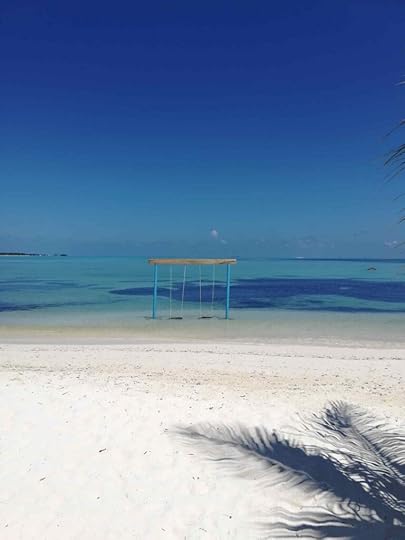
So, looking on the accommodation booking site (affiliate link) Booking Dotcom, I came across a small hotel on a local island in Maldives with lots of wonderful reviews.
The hotel is called (links to their Facebook Pages) Koimala and it’s on Maamigili Island in South Ari Atoll.
Koimala means ‘Whaleshark’ and the name Maamigili means ‘Whale Shark Island’.
It sounded perfect for us – especially as the total price of 14 nights for the dates we wanted – staying in a double room with private bathroom including breakfast each morning -was only 335 UK GBP (approx. USD$ 425) for both of us.
Yes – that’s for two weeks!


We researched getting to Maamigili Island and decided we’d take the local ferry from Male Airport Island (yes, the airport is on a small island) over to Male itself (cost US$1 each).
Be warned: if you take a private taxi boat you’ll pay an awful lot more!
From Male, we knew we’d have to wait for a couple of hours to take the local boat to Maamigili.
We were quoted US$ 35 each. Journey time 2.30 hrs.
Now, Maamigili is the only island in South Ari Atoll with an airstrip.
So, you should know that a (20-minute flight) is certainly an option.
But, as we were on a tight budget, we’d decided to take the local boat.
With a couple of hours to spare to the scheduled departure time, we walked around the centre of Male, to check out the city centre and see the busy fish market.
If you read my previous post Maldives: Holiday On A Budget you can see my photos and video snippets on Male!
 Click to see Maldives: Holiday On A Budget (Part One)
Click to see Maldives: Holiday On A Budget (Part One)In my previous post there’s also some more details of our boat trip from Male over to Maamigili Island.
When we eventually arrived at Maamigili, the smiling owner of Koimala Hotel was waiting to greet us at the dock.
And that’s the moment our wonderful and totally relaxing stay on Maamigili Island began!
After checking in and being shown to our room, which was clean and basic and had everything we need, we wasted no time in heading straight to the beach.
The sun was starting to go down and so we were in perfect time to watch a perfect Maldivian sunset!
As we walked along the sandy road (all the roads and paths on Maamigili are sand) from our hotel to the beach we noticed huge fruit bats swooping from the trees.
And I remembered seeing them the last time we’d been on holiday in Maldives.
But I’d forgotten about the amazing fruit bats and how huge they are here!
We found the beach by following the sandy track and the sound of waves lapping the white sand.
And, for the next two weeks, every night, we got to watch the sun setting over the Indian Ocean.
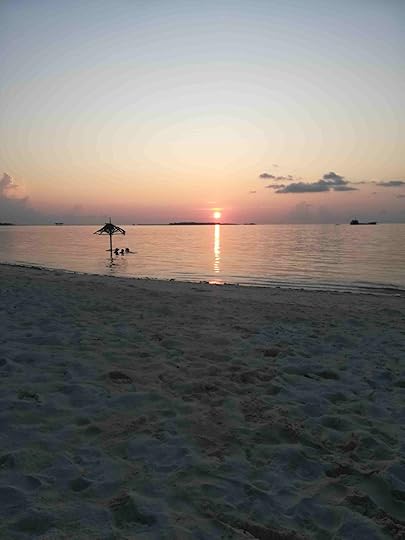
We ate at the hotel for breakfast (included in our room rate) and every evening (on top of our room rate).
Breakfast was very good. I asked for fruit and was given a plate of assorted tropical fruits every morning along with my choice of breakfast off the menu and coffee.
Dinner was also good. Lots of rice and fish so basic but always properly cooked and presented.
Take a look at the menus and prices. Our total bill for two weeks will surprise you!
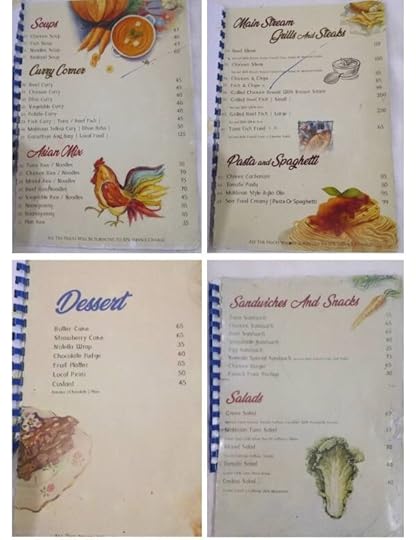 Prices are in Maldivian Rufiyaa (MVR)
Prices are in Maldivian Rufiyaa (MVR)Drinking water was provided free of charge which was welcome, refreshing, and surprising.
The hotel offers lots of optional extra-curricular trips and daily activities at extra cost.
Many guests did them all and were kept busy every day.
Us, not so much, we just wanted the beach and relaxation!
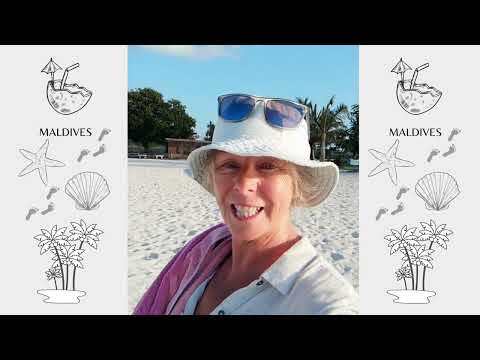
Activities offered were scuba diving at one of the local dive centres. Boat trips to swim with Whale Sharks and Manta Rays.
Being castaway for a day on an island sandbank with a picnic. And lots of others.
It was also actually possible to visit an island resort to use their facilities for the day.
Island resorts, of course, serve alcohol!
We didn’t go but some of our new friends reported back to us that the neighbouring private resorts where lovely for a day of pampering and great for taking holiday Facebook or Instagram photos with a (pricey) cocktail in hand!
We spent our mornings from 9.30am until noon and late afternoon from 4pm to sundown at the beach.
One beach on the island is for the use of guests and is known locally as Bikini Beach.
Bikini Beach is the only place on the island where it is acceptable to wear swimwear.
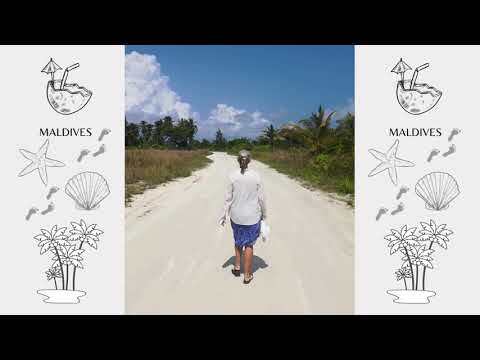
HOLIDAY ISLAND EXPECTATIONS
Other than Bikini Beach, elsewhere on the island, it is important to dress reservedly as Maamigili is an Islamic community.
I saw all the local women on the island are completely covered by headscarves and long dresses.
I was very aware of the restrictive dress code for women before I arrived and to be respectful (to the women) I had brought with me a sleeved long cotton cover-up to wear over my swimwear while walking through town and to and from the beach.
While at bikini beach, it is okay to sunbathe and to swim in a bikini or wearing other swimwear.
I didn’t mind covering up. But if you want to wear shorts and crop tops and similar stylish but western attire on your holiday, then you might find Maamigili and other local islands, a little too restrictive.
It’s only fair to point this out to you.
Another warning I would give is to be very careful in the heat and the sun.
I mentioned above the specific hours we spent at the beach. It’s so hot in Maldives.
The sun is so intense and it’s easy to overdo it in a short time of exposure.
We completely avoided being in the sun during the afternoon when it was hottest.
So many of the guests at our hotel (of which there is only nine rooms) were horribly sunburned.
So many had red raw skin (or no skin!) on parts of their body like arms legs, shoulders and backs.
Some had painfully swollen legs and feet.
This totally spoiled their holiday as they then had no choice to spend time in their room.
Be careful in hot tropical places so you don’t suffer from heatstroke or sunburn!
Wear sunscreen. Cover up. Drink lots of water.

EVENING ACTIVITIES
Perhaps another thing I should warn you about is a lack of things to do in the evening on the island.
And that, for us anyway, there was no opportunity for socialising in the evenings.
I could blame the lack of a bar – coffee or otherwise – as all hotel guests took to their rooms after dinner.
So, after 8pm, there was no one around.
I didn’t mind the first week, but once I’d caught up on sleep, I would have liked a bit of social interaction in the evenings.
Maybe it was just us?!
Or, maybe the troublesome evening mosquitoes were to blame?
See my post on biting flies and no-see-um’s!
 Beautiful Bikini Beach Maamigili Island MaldivesMaldives – maamigili island
Beautiful Bikini Beach Maamigili Island MaldivesMaldives – maamigili islandI hope you’ve enjoyed travelling with me to Maldives!
I wanted to show you that it is possible to see this amazingly beautiful place on a budget.
Maldives is not just for the wealthy.
I can personally recommend this alternative way of experiencing the Maldives to you.
Below are our total costs for TWO PEOPLE on a TWO WEEK Maldives holiday on a budget.
I’m quoting costs in US Dollars as that’s a universal currency also preferred in the Maldives.
 On Bikini Beach – Maamigili Island MaldivesTOTAL COSTS: TRAVEL – ACCOMMODATION – ALL FOOD/DRINK
On Bikini Beach – Maamigili Island MaldivesTOTAL COSTS: TRAVEL – ACCOMMODATION – ALL FOOD/DRINKFLIGHTS: Two economy return tickets with Air Asia from Kuala Lumpur to Male Maldives. $200
FERRY: Two tickets local ferry from Male Airport to Male Island: $2
SPEEDBOAT: Two return tickets on local scheduled speed boat from Male to Maamigili Island. $150
HOTEL: Two weeks in a double room accommodation (Booking Dotcom) with breakfast at Koimala Hotel: $425
DINNER: Two person’s evening meals (with drinking water) for two-weeks at Koimala Hotel: $100
AIRPORT HOTEL: One overnight stay at Hulhumale at Male (Booking Dotcom) before our return flight: $66
TOTAL COST: for two people including flights, boats, accommodation, and food, for two weeks = $943
That’s a two-week holiday in Maldives for two people for LESS THAN $1000!!

I hope you’ve enjoyed this post and my photos and video clips of what was a very special holiday and a wonderful way for the backpacking husband and I to celebrate our 40th wedding anniversary!
If I ever get to holiday in Maldives again, I wouldn’t hesitate to travel independently.
But I think, next time, I’d be tempted to ‘island hop’ around the local islands.
It’s possible to spend a week or just few days using the local boat transport, to experiencing staying on several different islands.
Although, independent travel is still relatively new to Maldives, so it could involve a bit of research into local boat schedules.
Have you been to Maldives?
Which island did you go?
Have I inspired you to try a local island?
What do you think of this alternative way to experience Maldives?
Let me know in the comments!
 Click to see Maldives On A Budget (Part One)
Click to see Maldives On A Budget (Part One)The post Maldives: Maamigili Island appeared first on The Backpacking Housewife.
Maldives: Holiday On A Budget!
Maldives: tiny tropical islands in the Indian Ocean with powder soft dazzlingly white sand beaches and swaying palm trees, surrounded by coral atolls and warm azure waters – a dreamy paradise and ultimate beach destination.
And, looking at the cost of a Maldives resort island holiday, it seems impossible to get there on a budget.
But, as we were already in Asia – and it was coming up to our 40th wedding anniversary – we were looking at taking a two-week holiday vacation using budget airline Air Asia to fly to the Maldives capital city of Male!
We saw that return tickets on Air Asia flying from Kuala Lumpur to Maldives were less than £100 UK at $100 USD each.

MALDIVES HOLIDAY ON A BUDGET
We’ve been fortunate to have visited Maldives on two previous occasions.
But that was many years ago when the only option for a Maldives holiday was a costly package deal.
Our first time in Maldives, we flew from the UK, via Dubai, and stayed for one week on a ‘rustic’ island resort called Biyadhoo.
Biyadhoo was a 40 minute speedboat ride from the airport island at Male.
It was wonderful. One hotel on a tiny island that you could walk around in about 15 minutes.
There was a small white sand beach, one restaurant serving three wonderful meals a day, a palm thatched bar, and a small ‘regimented block’ of apartment style rooms. But one week went by so fast there and I was sad to leave!
I can’t remember the exact cost – as it was a long time ago – but we used a travel agent and it was expensive.
 On Biyadhoo Island ResortMALDIVES RESORT ON A BUDGET
On Biyadhoo Island ResortMALDIVES RESORT ON A BUDGETBiyadhoo was a three-star ‘resort island’ and it had a wonderful charm and a laid-back vibe.
Everyone agreed one day it would be ‘done up’ and ‘priced up’ and in the process it would lose its rustic allure.
And, I see that is happening right now, because in 2024 Biyadhoo is closed for an upgrade!
Maldives All Inclusive ResortsOur second visit to Maldives was a two-week holiday on an island resort that was a little more luxurious.
We stayed at an all-inclusive resort called Adaaran Select Meedhupparu.
And we flew to the island on the east of the Northern Maalhosmadulu Atoll in the Maldives from Male in a sea plane.
It was amazing but I see its well out of our price range this time around.
Generally, island resorts in Maldives are priced are upwards of 100’s if not 1000’s of £/$ per night.
 Maldives Island Resort – Adaaran Select MeedhupparuTHE CHEAPEST WAY TO HOLIDAY IN MALDIVES
Maldives Island Resort – Adaaran Select MeedhupparuTHE CHEAPEST WAY TO HOLIDAY IN MALDIVESBUT, since we were last in Maldives, the Maldivian government has passed a ruling that local people living on local islands can open and run guesthouses.
A much more affordable option for a Maldives holiday on a budget and we do love a homestay!
We’ve stayed in homestays in various parts of Asia and we’ve always enjoyed a small family run accommodation.
The ‘downside’ of taking a Maldives holiday on a budget, however, is that there is no alcohol available on local islands.
This is because Maldives is a Muslim country and alcohol possession and consumption is illegal.
All the private resort islands have a special licence that enables them to serve alcohol to their guests.
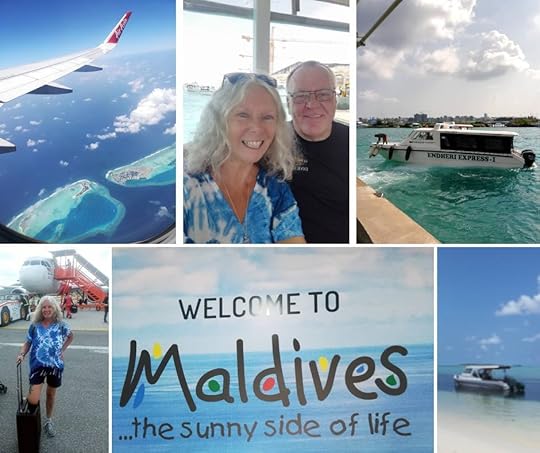 We were looking to return to Maldives to celebrate our 40th wedding anniversary
We were looking to return to Maldives to celebrate our 40th wedding anniversaryUp until that point – and looking to return to Maldives to celebrate our special wedding anniversary – we had already been travelling extensively through Asia, having just returned to Kuala Lumpur from South Korea, and Japan, and Taiwan.
So, we were looking for a relaxing and laid-back and idyllic beach holiday.
We didn’t really need or want to do anything except to relax on a while sand beach and swim in the warm clear ocean.
And, we decided that could manage for two weeks without a beer or a cocktail, and it would likely do us some good!
Looking on the accommodation booking site (affiliate link) Booking Dotcom, I came across a small hotel on a local island in Maldives, with lots of wonderful reviews.
The hotel is called (link to their FB Page) Koimala and it’s on Maamigili Island in South Ari Atoll.
Koimala means ‘Whaleshark’ and the name Maamigili means ‘Whale Shark Island’.
It sounded perfect!
Especially as the total price of staying in a double room with private bathroom including breakfast each morning on the dates we wanted was priced on (affiliate link) Booking Dotcom at only £335 GBP (approx. USD$ 425) for two weeks!
That price for accomodation was not per person but for both of us for two weeks!
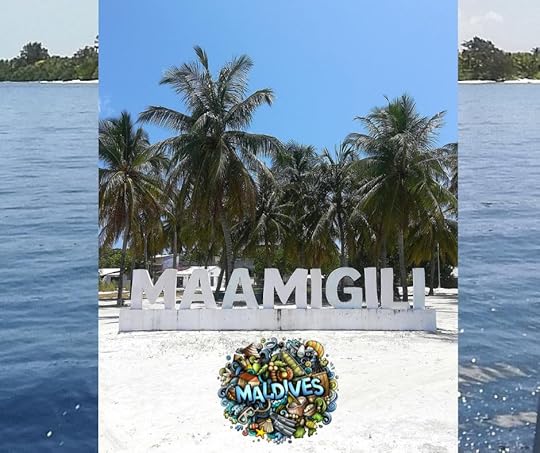 Maamigili means ‘Whale Shark Island’.HOW TO GET TO MAAMIGILI ISLAND – SOUTH ARI ATOLL
Maamigili means ‘Whale Shark Island’.HOW TO GET TO MAAMIGILI ISLAND – SOUTH ARI ATOLLIndependent travel is still quiet new to Maldives so we researched how we would get to Maamigili Island.
We decided we’d take the local ferry from Male airport island (the airport is on a small island) over to Male itself at a cost US$1 each.
Be warned: if you take a private taxi boat you’ll pay an awful lot more!
Watch my short video below with my impressions of our arrival in Male…
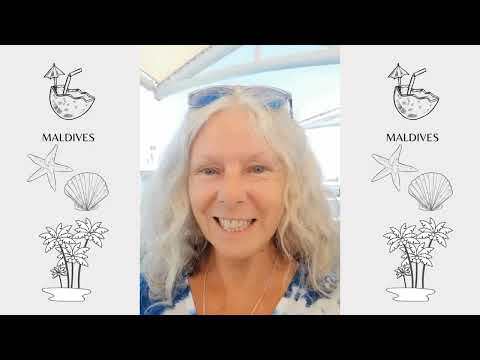
From Male, we knew we’d have to wait for a couple of hours to take the local boat to Maamigili.
We were quoted US$ 35 each. Journey time 2.30 hrs.
In my video I explain (wrongly!) that the journey took 40 minutes.
Now, Maamigili is the only island in South Ari Atoll with an airstrip.
So, you should know that a (20-minute flight) with domestic carrier FLYME is certainly an option.
But, as we were on a tight budget, we’d decided to take the local boat.
With a couple of hours to spare to the scheduled departure time, we walked around the centre of Male, to check out the city centre and see the busy fish market.
Take a look at my short videos for snippets of Maldivian City Life!
Back at the ferry dock, we saw our boat was now available and we could finally board.
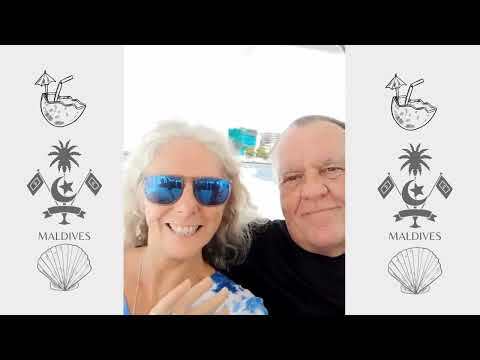
MALDIVES HOLIDAY ON A BUDGET
It was a long hot and quite arduous boat ride to South Ari Atoll be honest.
As you can see from my video, we sat at the back of the boat thinking we’d catch a nice breeze.
But instead, we got overheated and sunburned and after a couple of hours we both developed a terrible headache from the noise and vibration of the speedboat engines at full throttle directly behind us.
When we eventually arrived at Maamigili, the smiling owner of Koimala Hotel was waiting to greet us at the dock and after checking in, we wasted no time in heading straight to the beach, to see a perfect Maldivian sunset!
And for the next two weeks, every night, we got to watch the sun setting there and it was beautiful.
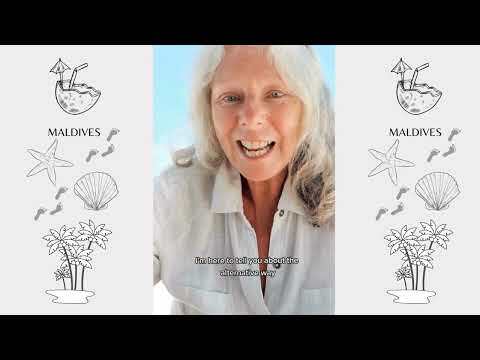
OVERNIGHT IN MALE MALDIVES
We returned to Male for an overnight stay on our final night in Maldives as we couldn’t do the return 2.30 hour boat journey and the flight on the same day.
Once back in Male we took the local public bus over the bridge to Hulhumale Island.
If you choose a private taxi then it will cost a lot more than a couple of dollars!
Hulhumale island is a small reclaimed strip of an island town adjacent to Male with lots of hotels for all budgets.
It is located conveniently close to the airport and a great place to have a relaxing overnight either before or after transiting to your destination island if your flight times don’t match up with your onward travel schedule.
Again, I booked our hotel using Booking Dotcom and we stayed at Hotel Paralian Hulhumale.
A double room for one night with breakfast included (served at the roof top restaurant overlooking the beach) cost us £52 GBP or $66 USD.
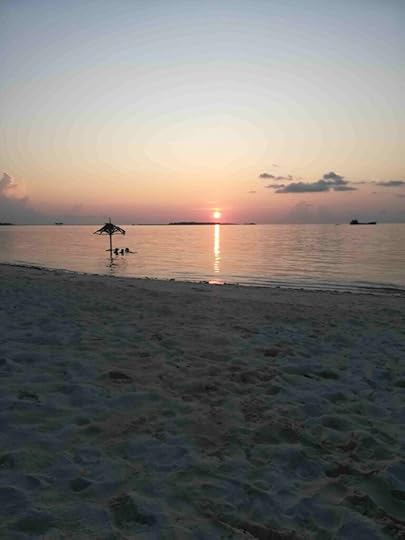 Sunset on Maamigili Island MaldivesSee my next post for more Maldives Holiday On A Budget!
Sunset on Maamigili Island MaldivesSee my next post for more Maldives Holiday On A Budget!PART TWO: MAAMIGILI ISLAND
See my next post in which I’ll show you what our two-week holiday was really like on Maamigili Island.
I have lots more photos and video clips to share with you and lots on information about Maamigili Island.
Plus I’ll have a total travel cost for our flights, boats, accommodation, and food, for the whole two weeks.
Travel with me to (Facebook Page) Maamigili Island on a fabulous Maldives holiday on a budget!
Has this post been helpful to you?
Are you dreaming of a holiday in Maldives?
Join me in my next post on Maamigili Island!
I RECOMMEND BOOKING YOUR MALDIVES ACCOMODATION USING BOOKING DOTCOM

I RECOMMEND YOU TRAVEL WITH TRAVEL INSURANCE
WHY NOT GET A NO-OBLIGATION QUOTE RIGHT NOW FROM WORLD NOMADS
The post Maldives: Holiday On A Budget! appeared first on The Backpacking Housewife.
January 28, 2024
Midlife Travel: How Can I Afford To Travel The World?
How can I afford to travel is a question that often appears in my inbox or pops up on travel forums.
How can I afford to travel the world long term?
How much money do I need for a year of travel?
How much does it cost to travel the world without a home base and as a nomad?
Not everyone wants to be a nomad but many wanderlusters are curious about how to cost out a few months of bucket list travel or perhaps a grown up gap year.
So the ‘how can I afford to travel’ question is often to try to definitively find out how much money is actually needed ‘in the pot’ to travel and pay for food and accommodation while travelling longer term.
And there lies the problem in answering how much it costs to travel.
Because a lot depends on if you’re high-maintenance or minimalist.
What seems like a lot of money to one person seems very little to someone else.
Also, what type of traveller are you?
Are you travelling solo or as a couple?
Are you a retired adventurer or a digital nomad?
Are you looking to tick everything off your bucket list?
Every person’s situation and expectations from travel are different.
Which is likely why I’ve avoided trying to answer this question so far!
It stands to reason that if you want to fly first class and stay in five-star hotels then you’ll need a huge pot of cash to travel.
And, maybe that’s not an issue for you?
But, if you are someone who needs to keep to a budget to travel then perhaps I can advise you?
Perhaps I can share my own secrets with you on how to maintain a lifestyle of travel?
On how the backpacking husband and I cope financially for the long term.
How we’ve managed to be location free and to keep travelling for over ten years.
It could be just a British quirk but I do think talking about (having or not having) money can be awkward.
It’s a bit like a confession, isn’t it?
At worst, it might come over as boastful.
Did we win the lottery? Are we rich?
No and no. But I might qualify the answer saying we might not be financially rich but we are rich in travel experiences.
We have certainly explored many ways of travelling over the years.
From high-end luxury flashpacking to shared facilities while backpacking.
And everything in between.
And, right now, we have no plans to stop travelling.
So in this post – I’m talking about my own money – and that makes it rather personal.
But if it helps to dispel the myth that you have to be wealthy to travel then it will be worthwhile.
First, we’re going to explore what kind of traveller you might be.
Then, I’m going to tell you exactly how we can afford to travel the world.
How we manage to balance travel expenses and protect our assets.
And, I think you’ll be surprised!
 How can I afford to travel the world long term?
How can I afford to travel the world long term?Table of Contents
HOW CAN I AFFORD TO TRAVEL THE WORLD?WHAT TYPE OF TRAVELLER ARE YOU?A SOLO TRAVELLERTRAVEL COUPLERETIREMENT TRAVELLERBUCKET LIST TRAVELLERCULTURAL TRAVELLERWELLNESS TRAVELLERGROUP TRAVELLERDIGITAL NOMADSABBATICAL TRAVELADVENTURE TRAVELLERVOLUNTEERINGHOW CAN I AFFORD TO TRAVEL THE WORLD?TRAVEL EXPENSESHOW TO BE TRAVEL SAVVYTRAVEL SAVVY RESEARCHHOW TO BOOK A SAVVY FLIGHTHOW TO BE ACCOMODATION SAVVYHOUSESITTINGVOLUNTEERINGHOW CAN I AFFORD TO TRAVEL THE WORLD?THE COST OF FOOD AND DRINKMAINTAINING TRAVELREVENUE STREAMSHOW DOES THIS HELP YOU? WHAT TYPE OF TRAVELLER ARE YOU? A SOLO TRAVELLER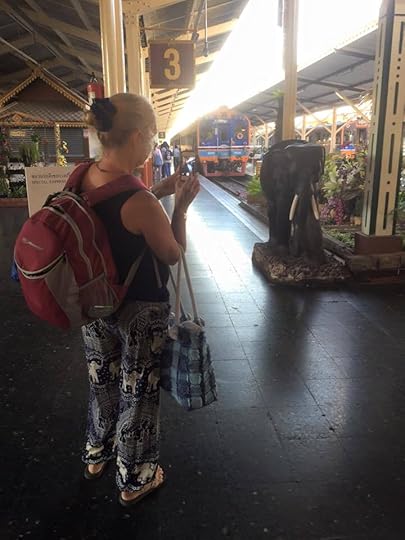 Chiang Mai, Thailand
Chiang Mai, ThailandPeople have various reasons for enjoying solo travel and many are happy (as I have done on occasion) to leave a partner behind while they go off to explore parts unknown.
There is a freedom to traveling solo that allows individuals to set their own schedule and make spontaneous decisions.
This flexibility can lead to more adventurous or unique experiences.
Although, on the flip side, some solo long term travellers say they occasionally experience decision fatigue from constantly having to plan and make choices about their itinerary, accommodations, dining options, and activities.
Also, one of the most commonly cited drawbacks of solo travel is the potential for loneliness.
But traveling alone often encourages interactions with locals and other travellers that can lead to making new connections and forming friendships along the way.
Overcoming challenges solo can build confidence and resilience and allows individuals to pursue their specific interests or hobbies without compromise.
Whether it’s photography, hiking, or cultural immersion, solo travellers have the freedom to focus entirely on what they love.
Traveling alone can often be more budget friendly as individuals have full control over expenses.
Although, my solo travelling friends do tell me, it can cost more to travel solo because you can’t benefit from cost sharing especially when it comes to accommodations being sold on room per night.
Solo travel allows individuals to tailor their experiences to their own preferences and interests, ensuring a fulfilling and meaningful journey based solely on their desires with the freedom to explore the world on their own terms.
TRAVEL COUPLE Honduras, Central America
Honduras, Central AmericaCouples travel offers its own set of advantages. I have on occasion travelled with a friend but mostly I’ve travelled as a couple with my backpacking husband.
There is of course always the potential while spending extended periods of time together for disagreements that test the patience and communication skills of both partners!
I’m happy to say that we thankfully get on well and enjoy each other’s company even after being married for 40 years and spending the past 10 years together 24/7!
Couples travelling together allows for shared memories and experiences, deepening their bond and creating a strong sense of connection and a strengthening of the relationship.
Traveling with a partner provides emotional support and companionship, making it easier to handle challenges together in unfamiliar or potentially risky situations. Partners can watch out for each other and provide assistance if needed.
Partners can divide tasks such as planning and booking accommodations, making the logistics of travel more manageable.
Couples can often split costs for accommodations, transportation, and meals, making travel more affordable compared to solo travel.
Traveling as a couple does require compromise and collaboration. It helps to have the same interests, preferences, and travel styles. Compromise is a tricky one – as it can often mean feeling obligated to meet each other’s needs and preferences – when making decisions or exploring new destinations.
Overall, couples travel provides the opportunity for partners to strengthen their relationship, create lasting memories, and enjoy the journey of exploration and discovery together.
RETIREMENT TRAVELLER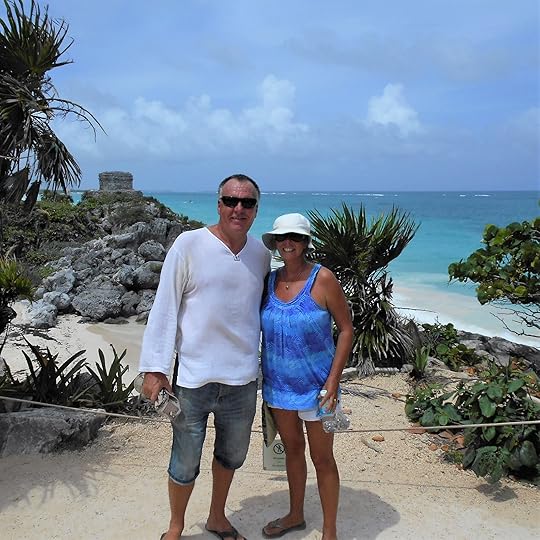 Tulum, Mexico
Tulum, MexicoYou might be early-retired empty-nesters like the backpacking husband and myself?
You might have decided to quit the rat race and retire early to travel and have fabulous experiences in other countries.
Or you might be of retirement age and planning to travel while you have good health and a pension to keep you comfortable in your senior years.
However you have retired, I expect you’ll still want to keep an eye on your budget, to avoid draining the pot.
I absolutely believe that travel in your 50s and 60s and in retirement is the perfect time to embrace a sense of adventure.
To explore off-the-beaten-path destinations, try new activities, and push your personal boundaries.
Travel provides the perfect opportunity to meet new people, make new friends, sample different food, explore new destinations, learn a new language, and immerse yourself in new and exciting cultural activities.
All experiences that may have been previously out of reach to you due to work or family commitments or financial constraints.
Do read my post on Third Age Travel: A Rediscovery of Travel.
Traveling in retirement can also have numerous health benefits for increased physical activity, improved mood, reduced stress levels, and enhanced cognitive function. I can heartily recommend it and if not now… when?
BUCKET LIST TRAVELLER Cairo, Egypt
Cairo, EgyptCan you be described as someone with an adventurous spirit who is passionate about life and enthusiastic about pursuing their dreams?
Have you created a list of destinations, new experiences, and goals that you are dedicated to checking off no matter how adventurous or ambitious it may be?
If so then you are a bucket list traveller!
Bucket list travellers are lifelong learners who are eager to expand their horizons, broaden their perspectives, and immerse themselves in new cultures, languages, and traditions.
They approach each adventure with a sense of optimism and excitement, curiosity, and open-mindedness, eager to soak up every moment and make the most of their experiences both big and small.
They understand the value of making memories and embracing the journey.
Bucket list travellers are committed to living life with purpose, passion, and a sense of adventure, knowing that every adventure brings new opportunities for growth and fulfilment.
If this is you – what’s on your bucket list?
Cultural TravelLer Ta Prohm Temple, Cambodia
Ta Prohm Temple, CambodiaCultural travellers are interested in immersing themselves in the local culture, history, and traditions of the places they visit.
If you are a cultural traveller then you’ll often seek out temples and museums, historical sites, festivals, and authentic culinary experiences.
You’ll prefer to interact with locals, learn a little of the local language, and engage in activities that provide a genuine insight into the customs and the etiquette and everyday lives of people in the destination you have chosen.
You’ll have an appreciation of art, music, and look for opportunities to attend concerts, performances, exhibitions.
Travel may be used to pursue your own cultural and creative interests such as writing, photography, art, or music, with the freedom to dedicate uninterrupted time to these pursuits.
Do read my Step By Step Guide to Slow Travel.
Cultural travellers are often interested in responsible tourism practices that support local communities, preserve cultural heritage, and minimize negative impacts on the environment.
They seek out experiences that promote sustainable tourism and contribute to the well-being of the destinations they visit.
WELLNESS TRAVELLER La Digue, Seychelles
La Digue, SeychellesTravel can also be a time for focusing on wellness and health, whether you’re looking for a spiritual retreat to practice mindfulness, a digital detox, or outdoor activities, wellness travel offers a valuable opportunity for personal growth.
Some are look for relaxing spa treatments and mind-body practices such as tai chi, qigong, pilates, yoga and meditation to reduce stress and promote mental clarity.
Many wellness destinations offer a variety of fitness activities in natural and scenic surroundings.
The photo above is of me cycling through an avenue of palm trees in the Seychelles.
Some wellness retreats offer holistic therapies and alternative healing modalities, such as acupuncture, reiki, aromatherapy, and sound healing, to restore balance and promote healing on physical, emotional, and energetic levels.
Group TravelLer Water Cay, Caribbean
Water Cay, CaribbeanGroup travel provides an instant social network of like-minded individuals who share a common interest in the destination or itinerary. This can be particularly beneficial for solo travellers or those looking to meet new people and make new friends.
Many group tours are led by knowledgeable guides or tour leaders who provide valuable insights, historical context, and insider tips about the destinations visited. This expertise enhances the travel experience and allows participants to learn more about the places they’re visiting.
Group travel often includes pre-planned itineraries, accommodations, transportation, and activities, eliminating the need for participants to organize logistics themselves. Saving time and reducing stress and allowing you to focus on enjoying the journey.
Traveling in a group can enhance safety and security, particularly in unfamiliar or remote destinations and provide assistance in case of emergencies.
DIGITAL NOMAD Dordogne, France
Dordogne, FranceMany people these days work as digital nomads and are in their pre-retirement years but location free while working remotely.
Although, as I’m often a working nomad myself, I know having very good internet access is important to keep up with online paid work. This situation can put restrictions on where in the world you can feasibly work for longer periods of time.
But more and more digital nomad visas and high speed connections are now being offered around the world.
SABBATICAL TRAVEL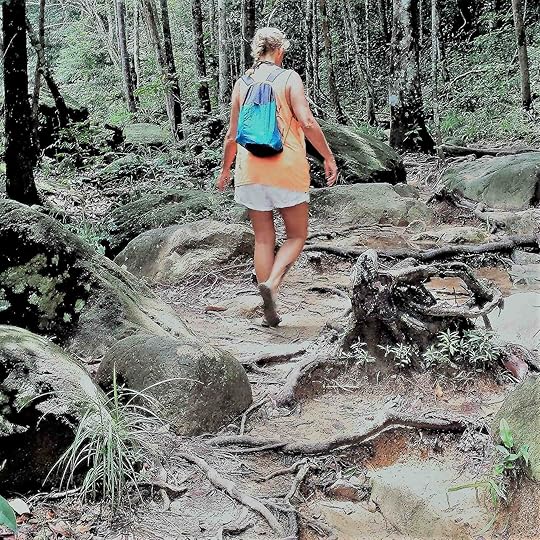 Koh Chang, Thailand
Koh Chang, ThailandMaybe you’re taking time out of the workplace to travel while you’re still reasonably young and fit?
Sabbatical travel offers an opportunity to take a break from the demands of work and recharge mentally and physically.
This can help prevent burnout and improve overall job satisfaction upon returning to work.
Maybe you want to train and qualify for something new or have ambitions for adventure travel.
Do read my guide on Over 50’s Guide To A Midlife Gap Year.
Adventure TravelLer The Nile River, Egypt
The Nile River, EgyptAre you someone who continues to pursue adventurous and exhilarating experiences well into your later years, defying stereotypes about aging and embracing a life of excitement, challenge, and exploration!
Are you always eager to embark on new experiences, push your limits and even seek out adrenaline-pumping activities, ranging from scuba diving, skydiving, bungee jumping, trekking to remote destinations, or climbing challenging peaks?
Do you prioritise physical fitness and health to ensure you’re capable of participating in adventurous activities?
Do you draw on your lifetime of knowledge and skills to make informed decisions and appreciate the journey?
Adventure travellers are determined to live life to the fullest and serve as inspiration and role model to all age groups.
Demonstrating that age is no barrier to adventure and it’s never too late to pursue your passions and explore the world.
Whether you choose to travel solo or with like-minded companions – if all or some of the above describes you – then you are an adventure traveller!
VOLUNTEERING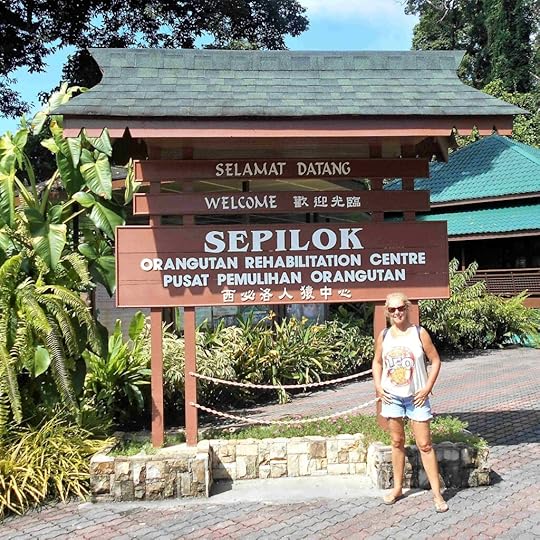 Sepilok, Borneo
Sepilok, BorneoVolunteer travel, often referred to as voluntourism, combines the elements of travel and volunteering, providing a traveller with the opportunity to make a positive impact while experiencing new cultures.
There are lots of volunteering organisations online but do your due diligence and proper research before committing.
I have volunteered on a turtle conservation project, on a remote island off Malaysia, which was one of the most rewarding experiences of my life.
Do read my article Volunteering: Sea Turtle Conservation.
The backpacking husband has volunteered on environmental conservation projects around the world offering his skills as an experienced and qualified scuba diver.
For example: he has volunteered on coral reef conservation and been involved in shipwreck salvage in the Caribbean.
Both exciting and rewarding projects for him while travelling.
Volunteering while travelling can involve participating in various on environmental conservation, reforestation efforts, wildlife preservation, or beach clean-ups.
Also community service projects such as building houses, schools, or community centres, renovating infrastructure, or assisting with environmental conservation efforts.
It can mean engaging in educational initiatives, including teaching English, providing tutoring sessions, or assisting local teachers in classrooms.
Some volunteers with medical or healthcare backgrounds offer their services to provide healthcare assistance in clinics, by organizing health outreach programs, or conducting health education workshops.
Volunteering in orphanages involves providing care, support, assisting with daily routines and offering companionship to children in need.
Some voluntourism programs focus on animal welfare involving activities such as caring for rescue animals and supporting sanctuaries.
Volunteers with specific skills, such as IT, agriculture, or vocational expertise, may provide training workshops to help local communities develop sustainable skills and improve their livelihoods.
Do you want to volunteer for a project you feel passionate about in another country/continent?
HOW MUCH WILL IT ALL COST?The surprise here is that it’s probably much less than you think.
As long as you remember that you’re not on holiday all the time and that it’s important to be travel savvy.
For example: a flight might cost a lot but once you’re there you can travel using budget airlines and trains and buses.
It’s far cheaper to travel around Asia, for example, than around the USA or UK or Europe.
The same can be said for the cost of accommodations and meals.
But then we are back to the question of expectations again.
Are you high maintenance or a minimalist?
To be clear, the backpacking husband and I might be minimalists, but we do maintain three uncompromising essential elements to our travel standards in regard to personal security, transportation, and accommodation.
We need to feel safe and comfortable and clean and in that order.
We maintain these standards and stay on budget by mixing up our travel experiences with low-priced travel, mid-priced-travel, and the occasional splurge on luxury.
HOW CAN I AFFORD TO TRAVEL THE WORLD?So how do the backpacking husband and I cope financially in the long term?
How have we managed to be location free and to travel for over ten years?
I suppose it’s because learned to be travel savvy.
Ten years ago we sold everything we owned – our house, cars, furniture and stuff – to liquidate our assets into cash for when we set off on our travels to provide a safety net.
But that was ten years ago.
We now travel with hand luggage only and we have few possessions.
For us, no property means no responsibility and no associated costs.
And, in return, there is both physical and financial freedom.
So the secret to travelling long term is perhaps in keeping costs down to a minimum.
To compare: what are the basic living costs in your life?
I’m guessing from past experience you’ll be paying out on: a mortgage, property taxes, insurances, home maintenance, utility bills, car payments, car tax and car maintenance, etc.
Now… imagine life without any of those expenses.
TRAVEL EXPENSESI see our financial situation as maintaining a fine balance of expenses vs assets.
We do need money to travel – to sleep securely with a roof over our heads – and to eat.
And I like to keep a spreadsheet when costing out a travel venture.
That way, I’ll have all the dates and reference numbers and details and costings all in one place.
It’s really easy to forget and get confused while travel planning and it helps to balance the budget!
Many of my travel posts have costings to show how much (or how little) we paid for flights and accomodation.
Check out my 14 Days and Five-City Japan Itinerary to see how this ENTIRE TRIP cost us less than 1000 GBP.
HOW TO BE TRAVEL SAVVYFlights and other transport costs are a major expense so it pays to be practical savvy.
Do make sure your bank cards are travel friendly and not going to charge you exorbitant fees for using them abroad.
Most importantly: Is your passport valid? How many free pages do you have? How long do you have before it expires?
Where are you planning to travel to and how long will you stay?
What are the country’s current entry requirements?
Do you need to apply for an entry visa or can you get it on arrival?
Do you have all the recommended travel vaccines?
What about travel insurance? What level of cover do you need?
Do read my own article and comprehensive Guide To Travel Insurance for Over 50s.
I do also recommend you get a no-obligation quote right now (affiliate link) from World Nomads.
 TRAVEL SAVVY RESEARCH
TRAVEL SAVVY RESEARCH
What’s the average cost of a flight to where you are going?
Should you get a one way ticket or a return flight?
If you book a one-way do you need an onward flight ticket to satisfy an entry visa?
Is it less-expensive to fly midweek rather than on a weekend? Probably!
Is it a direct flight or is there a layover and for how long?
Will you realistically make the connecting or onward flight?
Make sure to check important dates at your destination country and avoid the extra expense of travelling on public holidays.
Examples would be the Lunar New Year in Asia and during Ramadan in Muslim countries.
HOW TO BOOK A SAVVY FLIGHTWe use Skyscanner (not a paid link) to source and cost and plan our flights.
But we ALWAYS book directly with the airline. This is because, if there are delays or problems with the flight, the airline won’t be able to assist you if you booked your ticket through an agent or other third-party.
Set up travel alerts to show when flight prices drop to your chosen destination.
Then when you see a flight at your target price – book it – don’t refresh the page or it will be gone!
Be flexible on dates and don’t dismiss considering flights that have connections or long lay overs.
Join airline loyalty programmes and collect points for free future flights or upgrades.
On arrival at your destination: plan how will you get from the airport to your accommodation.
We always use cheaper local transport options rather than expensive taxis.
We even did this on holidays with the kids years ago. All the other families would exit the airport to pile into a taxi or a waiting private coach. But we always took the stairs down to the public bus depot to take a local service bus!
HOW TO BE ACCOMODATION SAVVYFor a one or two night stay, I enjoy staying in a hotel.
We can sometimes book a room or a suite on accumulated hotel points.
If not entirely for free on points then on a basic room rate with a welcome upgrade.
So do join those hotel chain loyalty programmes!
I also love a budget hotel for a few nights and look for breakfast included.
If not a budget hotel, then a private room in a hostel is perfectly okay too.
For a stay of a week or so and for a more personal and homely touch, then private homestay is wonderful, and is often my preferred choice of accommodation.
If we’re planning to stay somewhere for more than a couple of weeks or months – which we often do – then we like to rent an apartment, or a house, or a hut on a beach, and live like locals for a while.
I mostly use (affiliated link) Booking Dotcom to source and book accommodations.
HOUSESITTING Click to see my post on Housesitting
Click to see my post on HousesittingWe also often do housesitting in between our travels. This means we enjoy staying in someone’s home free of charge in return for responsibly and conscientiously looking after their house and property and (sometimes) animals while the homeowner is away.
Housesitting suits us very well. It allows for precious down time to relax between travels.
Housesitting also helps big time in balancing out our budget with rent-free accommodation for a while.
We’ve done housesitting in the Caribbean but most of our housesitting is done with extended stays in France.
I’ve written a comprehensive post on housesitting that you might like to read if you’re curious about housesitting and wondering how to go about applying for housesits.
Click the (affiliate) banner or the Promo Code Button to find out more about Trusted Housesitters.
 USE PROMO CODE ’12TRUST’ TO GET 12% DISCOUNT
VOLUNTEERING
USE PROMO CODE ’12TRUST’ TO GET 12% DISCOUNT
VOLUNTEERING
Another way we’ve occasionally enjoyed free accommodation is when we’ve been volunteering.
Volunteering is a fabulous way to travel and to have amazing travel experiences.
The backpacking husband, who loves to scuba dive, worked to achieve his life-long dream of becoming a PADI IDC Staff Instructor over the first three years that we were travelling.
He trained as a Divemaster in the Caribbean and he did his Instructor Development Course in Thailand.
Now he volunteers on coral reef, conservation, and wreck salvage projects all over the world.
We’ve sometimes been given a place to stay in return for his time and his expertise on these projects.
 The backpacking husband is a highly qualified scuba diverHOW CAN I AFFORD TO TRAVEL THE WORLD?
THE COST OF FOOD AND DRINK
The backpacking husband is a highly qualified scuba diverHOW CAN I AFFORD TO TRAVEL THE WORLD?
THE COST OF FOOD AND DRINK
Whether home or abroad you need to eat and drink. As choice and preferences for food and drink are such personal issues, it’s hard for me to cost it out for you.
All I can do is tell you that while we’re travelling we often find local food is often a lot less expensive – especially in countries like South East Asia – than in our ‘home’ country.
If we’re renting a house with a kitchen for example, I’ll usually shop and cook.
But if we’re somewhere like Thailand it’s generally cheaper to eat out.
We do like a nice restaurant. But we are also more than happy to enjoy street food.
Street food in Asia is amazing and some even have a Michelin Star!
MAINTAINING TRAVEL Click to see my post celebrating Ten Years of Nomadic Travel
Click to see my post celebrating Ten Years of Nomadic TravelSo, in our situation, we keep a close eye on spending.
But how do we continue to make money while travelling?
The backpacking husband and I were both 54 years old when we started to travel long term.
And, as mentioned, we’d liquidated all our possessions to fund our initial travels.
At the age of 55, the backpacking husband drew one of his private pensions.
This gives us a small regular monthly sum to help towards our regular outgoing costs of food and accommodation.
At age 60 he drew a second small private pension.
We are now both 64 years old. Unfortunately not yet eligible for our State Pensions.
For our State Pensions we’ll have to wait until we are aged 66.
So, right now, my backpacking husband is retired.
I’m still officially self-employed but I don’t work all the time.
I tend to work sporadically and then binge work when travel and time allows.
REVENUE STREAMS
When I do work, it’s not on one thing, but lots of little things that add up to something.
Firstly, I’m a self-published author. I sell my books worldwide through Amazon KDP Publishing as ebooks and paperbacks.
Amazon KDP pays royalties on book sales monthly.
See my Books Page for my complete list of published novels.
I’m also published by HarperCollins in London with my Backpacking Housewife series of books.
I receive monthly royalty payments on sales from HarperCollins.
I also receive annual royalty payments from ALCS and PLR (Author’s Lending and Public Library) for my books borrowed by the public through the British Library System.
I work as a Freelance Book Editor. See my Author Services Page for my rates.
This means I work on manuscripts with authors aiming for publication.
My job is to carefully read the work and provide a helpful and fully explored structural report on all aspects of the writing.
My expertise is based on my own experiences as an author over the past 20 years, and from working with a top publishing house and writing industry professionals, also over many years.
I’m generally fully employed for several months of the year from doing editing work.
I also get paid to write lifestyle articles for magazines and travel features for online publications.
In addition, I write for my travel website here at The Backpacking Housewife Dotcom.
As you browse through my website, you might notice I have banners and text linking to affiliate partnerships.
These companies include: Amazon, Trusted Housesitters, World Nomads Travel Insurance, Booking Dotcom and Klook
These are partners whose products I buy for myself and so would recommend to you.
I earn a small commission if you click through one of my links and decide to make a purchase.
I’m thankful to you if you do choose to use my affiliate links as it helps support the cost of running this website.
I also do a lot of unpaid work too like media interviews and podcast interviews that I really enjoy.
 Check out my MEDIA PAGE
Check out my MEDIA PAGEThese interviews allow me to chat with other travel lovers and wanderlusters and also give promotional opportunities.
These opportunities will hopefully increase sales of my books or hits on my website and resulting commissions.
HOW DOES THIS HELP YOU?And, if I can think up any other little revenue streams, I’ll certainly let you know!
Now, you might be thinking, that’s all very well. But how does that help me?
My point here is that you might like to explore your own hobbies, passions, skills and strengths.
And reimagine how you might commercialise those things to bring in an income while you travel.
Some ideas that come to mind include teaching yoga, teaching English, or another language while abroad.
I’m sure you can think of more and some that you might be able to turn into a money making opportunity?
Yes, it will likely take time, as often these things do.
But I challenge you to think big and be bold about it!
It was while we were travelling that I got my three book deal with HarperCollins.
 BROWSE MY BOOKS ON AMAZON
BROWSE MY BOOKS ON AMAZONIt was also while we were travelling that the backpacking husband did all his dive training.
So… that’s it. That’s how we afford to travel the world long term.
We think big and spend small!
And, right now, I’m reminded of one of my favourite travel quotes:
It’s nice to get out of the rat race but you do have to learn to get along with less cheese.
Gene Perret
This is a very personal post for me in talking about money. Has it helped you?
Has it been encouraging and has it reassured you that perhaps you don’t have to be rich to travel?
I am of course always aware that being able to travel – however you travel – is a great privilege.
I’m very thankful that I can travel and have no regrets about having taken the big step ten years ago to going nomad.
Has this post got you pondering on your own travel style and personal resources?
Are you thinking about how you might apply this information to your own future travel ambitions and plans?
Do let me know in the comments or contact me.
Ask questions!
I’d be delighted to hear from you!

The post Midlife Travel: How Can I Afford To Travel The World? appeared first on The Backpacking Housewife.
January 26, 2024
Taiwan – The Lantern Festival
I was so excited to be in Taiwan for the Lantern Festival!
Especially as it was to be the first time the festival had been held in the City of Taipei – the capital city of Taiwan – for twenty-three years.
The festival, launched on the fifteenth day of The Lunar New Year promised to ‘Light Up The Future’ for The Year of the Rabbit.
We’d organised our entire Taiwan trip around the Lantern Festival.
We’d arrived in Taiwan a week earlier and had travelled by Taiwan High Speed Rail (THSR) on the Bullet Train from Taipei to the midpoint City of Taichung for a few days before exploring further south and the port City of Kaohsiung.
Then, again by train, we’d travelled the length of the country on our return to Taipei in anticipation of The Lantern Festival.
Ahead of the first night’s amazing events, during the daytime, we went into central Taipei to explore the festival areas.
The rabbit and carrot theme was already very much in evidence.
Do watch my short videos below!
We could hardly wait for darkness to fall and the lights to shine.
When I expected our eyes would be popping like rabbits’ eyes in headlights!
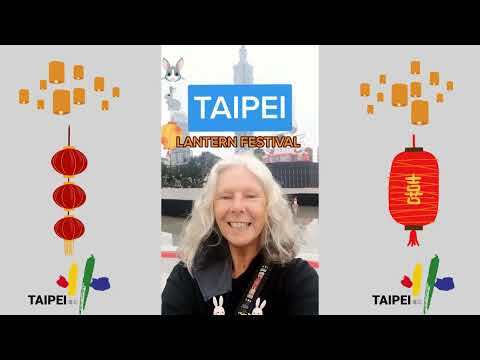
We could hardly wait for darkness to fall and the lights to shine!THE HISTORY OF THE TAIWAN LANTERN FESTIVAL
The festival has its roots in Chinese tradition and dates back over 2,000 years.
Taipei is the original birthplace of The Taiwan Lantern Festival.
It is said to have originated during the Han Dynasty and was initially celebrated to honour Taiyi – the God of Heaven and to pray for good harvests and favourable weather.
One of the most iconic aspects of the Lantern Festival is the stunning lantern displays.
Elaborate and colourful lanterns are crafted in various shapes and sizes, often depicting animals from the Chinese zodiac, mythological creatures, or symbols of good fortune.
These lanterns are often made using traditional methods and materials, creating a mesmerizing spectacle.
Lanterns are symbolic of letting go of the past and embracing new beginnings.
People write their wishes or prayers on the lanterns before releasing them into the sky or floating them on water, symbolizing the release of worries and troubles and the hope for a bright future.
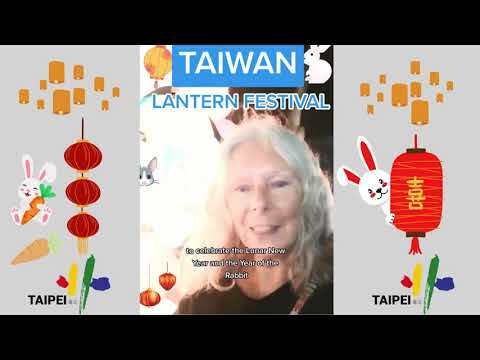
I was so excited to be in Taiwan for the Lantern Festival!THE BRILLIANT LIGHT OF THE JADE HARE
The Taiwan Lantern Festival location in Taipei is held in the centre of the city in two main areas: The National Dr. Sun Yat-sen Memorial Hall and Taipei City Hall Square.
The Main Lantern is of course The Brilliant Light of the Jade Hare.
But for the first time, the main lantern is using robot technology, which is to pay ‘homage to Taiwan’s achievements in the semiconductor industry’.
The Secondary Lantern is The Spiral Dragon which brings prosperity and blessings and is inspired by Chinese folk tales.
The lantern is ‘animated vividly every 30 minutes.’
The star of the Third Lantern is a family of giant Taiwanese blue magpies perched on a colourful tree.
This heart-warming display is also animated with light and sound every 30 minutes.
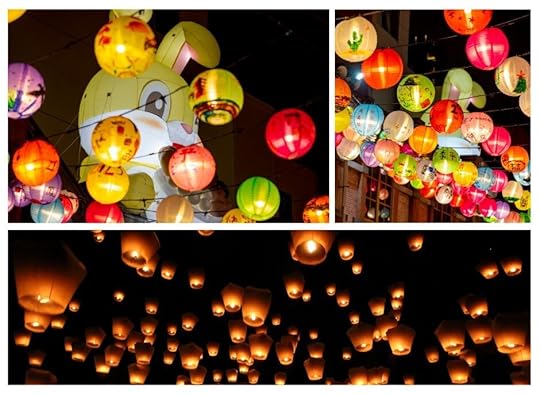
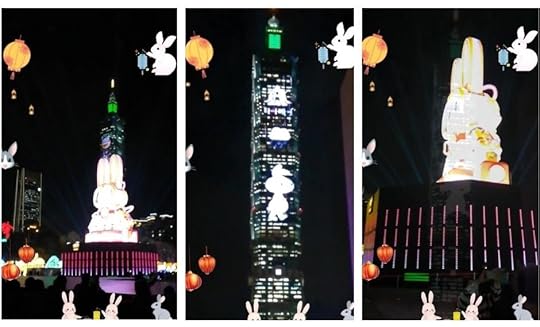 Taiwan Lantern Festival – Year of The RabbitFOUR MAJOR DISPLAY ZONES
Taiwan Lantern Festival – Year of The RabbitFOUR MAJOR DISPLAY ZONESThe Beacons of Light Display Zone (光展區)
Fount of Light Display Zone (源展區)
Lights of the Future Display Zone (未來展區)
Central Display Zone (中央展區)
Also six sub-lights displays and over 300 Lantern Installations.
 A Lantern of A Giant Taiwanese Blue Magpie Year of The Rabbit
A Lantern of A Giant Taiwanese Blue Magpie Year of The Rabbit The main theme of Year of The Rabbit Display Zone. This includes the background ‘projection mapping’ which will produce cute colourful animated rabbits jumping and running up and down the Taipei 101 Tower.
The International Friendship Lantern Area invites you to travel around the world with captivating lanterns from Japan and other countries.
Lights of the Future represents beacons of light and a futuristic spirit, vibrant culture and future technologies.
We wandered around this exuberant event for a few hours, making memories and really enjoyed soaking up the sparkling atmosphere of fun and excitement and wonder, in this ‘Disneyland without rollercoasters!’
I could hardly wait!
 TAIWAN LANTERN FESTIVAL FACTS
TAIWAN LANTERN FESTIVAL FACTSOver the past six years leading up to January 2024, several cities in Taiwan have hosted the Lantern Festival.
The Taiwan Lantern Festival is also known as the Yuanxiao Festival.
It is a significant event celebrated on the 15th day of the first month in the lunar calendar and marks the end of the Chinese New Year celebrations.
The Lantern Festival is celebrated with vibrant fireworks displays, adding to the festive atmosphere.
Additionally, there are cultural performances such as dragon and lion dances, traditional music, and folk dances, showcasing Taiwan’s rich cultural heritage.
The Taiwan Lantern Festival attracts tourists from all over the world, drawing large crowds to witness the spectacular lantern displays and partake in the festivities.
Each year, different cities in Taiwan host the festival, offering visitors a chance to experience the unique cultural traditions of the region.
While rooted in tradition, the Lantern Festival has also embraced modern technology and innovation.
In recent years, there has been a trend toward incorporating LED lights and interactive elements into the lantern displays, blending tradition with contemporary art and technology.
Overall, the Taiwan Lantern Festival is a celebration of culture, tradition, and community spirit, bringing people together to usher in the new year with joy and hope for the future!
Hence the theme of the Taipei Lantern Festival of ‘Light Up The Future’.
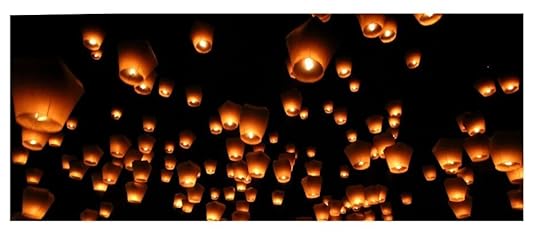
The Lantern Festival is a significant event in Taiwan and has been celebrated widely across various cities.
Taipei: Being the capital city, Taipei is the most famous when it hosts the grand celebrations for the Lantern Festival
Kaohsiung: As one of the major cities in southern Taiwan, Kaohsiung hosts elaborate lantern displays and events during the Lantern Festival.
Tainan: Another significant city in southern Taiwan, Tainan is known for its historical sites and vibrant culture, making it a popular location for Lantern Festival celebrations.
Taichung: Located in central Taiwan, Taichung is known for its annual Lantern Festival events, which often attract both locals and tourists.
Yunlin: Yunlin County, while not a city itself, has hosted notable Lantern Festival celebrations, particularly in its larger towns such as Douliu.
Pingxi (New Taipei City): Though technically part of New Taipei City, Pingxi is often distinguished for its unique Lantern Festival celebrations, particularly its Sky Lantern Festival where thousands of lanterns are released into the night sky.
 Click to explore our 12 Day Itinerary for Taiwan
Click to explore our 12 Day Itinerary for TaiwanAre you planning a trip to Taiwan?
Would you plan your trip around the lantern festival?
Let me know – I’d love to hear from you!
The post Taiwan – The Lantern Festival appeared first on The Backpacking Housewife.
January 22, 2024
Taiwan – Michelin Star Street Food
I’m in the Taiwan capital city of Taipei in search of Michelin starred street food at one of the most famous street food markets in Taiwan – The Ningxia Night Market!
With its moniker of ‘Taipei’s Stomach’ the Ningxia Night Market in Datong District, Taipei, is one of the oldest markets in the city.
It’s also one of the most popular with locals and tourist alike.
I’m told on authority that the oyster omelette (O-a-chian) here is the very best in Taiwan.
And not only does it have the secret and delicious signature sweet and tangy Taiwanese sauce drizzled over it – it also has a Michelin Star to its name – wow!
Having already sampled this delightful Taiwanese special oyster omelette in both the Feng Chia Night Market in Taichung and the Liuhe Night Market in Kaohsiung, I can hardly wait to find out if ‘The Best in Taiwan’ claim is true!

NINGXIA NIGHT MARKET OYSTER OMELETTE
The oyster omelette in my sights is the Yuen Huan Pien Oyster Egg Omelette.
I find it not in the line of street stalls on Ningxia Road but as an open-fronted shop (booth #46) where giant omelette pans have been dressed in whisked egg batter and succulent fresh oysters since 1965.
We wait in line for quite a while before it’s our turn.
But where in the world can you eat Michelin Star food for so little cost?
Verdict: Amazing – did you see my video!?
Cost: 85 $NT or approx. USD $2.70
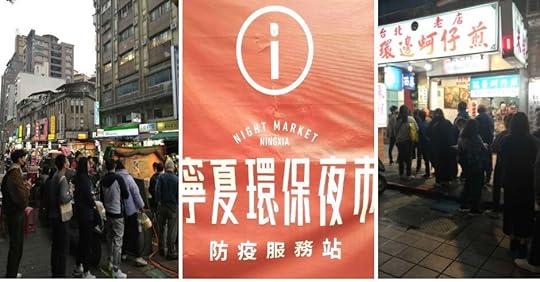 We wait in line for quite a while before it’s our turn!MICHELIN STAR STREET FOOD
We wait in line for quite a while before it’s our turn!MICHELIN STAR STREET FOODNingxia Night Market is in a narrow street and has a busy ‘traditional Taiwan’ vibe which I really liked.
But, of course, I was there to try for the Michelin Star Street Food.
In The Michelin Guide these vendors come under the section known as Bib Gourmand which, in France, is a distinction that guarantees a quality meal in an establishment where you can treat yourself even on a small budget.
I could easily guess which food carts were the Michelin Star vendors.
And, I didn’t have to see the proudly displayed certificate, because I could tell just by the length of the lines of people patiently waiting to be served!
Liu Yu Zai’s Taro Balls (stall #91): We waited in line for so long we were hungry again.
Michelin recognized Liu Yu Zai for his now famous deep-fried salted egg and pork meat taro balls.
Watching the Taro Balls being made – in the hundreds – was fascinating.
Verdict: Crispy and chewy and delicious!
Cost: 110 $NT or approx. USD$3
 Setting up at Michelin Starred Liu Yu Zai’s Taro Balls (stall #91)
Setting up at Michelin Starred Liu Yu Zai’s Taro Balls (stall #91)Rong’s Pork Liver Soup (stall #10): Another Michelin market stall has been serving his Pork Liver Soup for over 60 years and was listed in the Michelin Guide Taipei selection in 2019.
Verdict: Rich nourishing and meaty flavour with warming ginger and strips of tender liver – no blood taste.
Cost: 100 $NT or approx. USD$3
Fang Chia Shredded Chicken on Rice (stall #60): Michelin Star Tender shredded chicken in soy sauce with rice.
Verdict: The best of the best chicken and rice. What’s not to love!?
Cost: Cost: 100 $NT or approx. USD$3
WHAT TO EAT AT NINGXIA NIGHT MARKET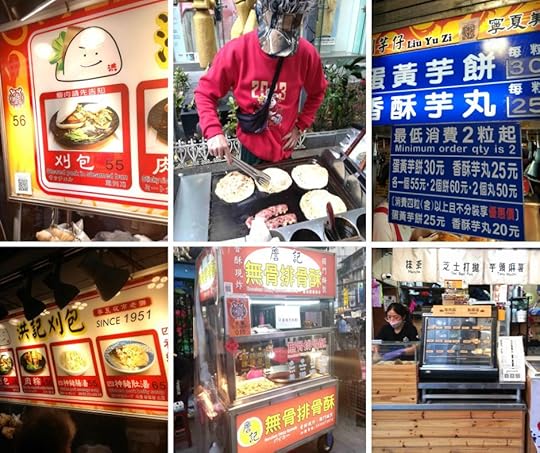 Most vendors have been trading at Ningxia Night Market for over 50 years
Most vendors have been trading at Ningxia Night Market for over 50 years Klook.com (function (d, sc, u) { var s = d.createElement(sc), p = d.getElementsByTagName(sc)[0]; s.type = "text/javascript"; s.async = true; s.src = u; p.parentNode.insertBefore(s, p); })( document, "script", "https://affiliate.klook.com/widget/fe..." );
Klook.com (function (d, sc, u) { var s = d.createElement(sc), p = d.getElementsByTagName(sc)[0]; s.type = "text/javascript"; s.async = true; s.src = u; p.parentNode.insertBefore(s, p); })( document, "script", "https://affiliate.klook.com/widget/fe..." );At Ningxia Night Market there are around 180 food stall vendors and 20 ‘booths’ or open fronted shops selling food every night of the week.
Most street food vendors here are well established and have been trading at Ningxia for over 50 years.
Here are just a few more (from a choice of 200) suggestions for foods you might try!
Nui Mama (#44) for delicious beef dishes with noodles.
Zhi Gao (#034) for fragrant rice dishes.
Xiao Chun Lao (#161) for steamed buns and braised dishes.
Qiu Yun Run Bing (#043) for savoury pancakes.
Hong Ji (#85) for scallion pancake rolls and fusion snacks.
Signs are also written in English making the market particularly tourist friendly.
Taiwan Today says: “Tasting a nation’s food is the easiest way to get close to its culture.”
My verdict: If you haven’t eaten street food in Taiwan – can you really say that you’ve experienced Taiwan?
 Mmmm… Where do you stand on Stinky Tofu?HOW TO GET TO NINGXIA NIGHT MARKET
Mmmm… Where do you stand on Stinky Tofu?HOW TO GET TO NINGXIA NIGHT MARKETBy MRT: Red Line. Shuanglian (R12) MRT Station and Zhongshan(R11) MRT Station are the closest to the Ningxia Night Market. At Shuanglian walk out Exit 1 and head west down Minsheng Road for ten to fifteen minutes until you reach Ningxia Road. Take a right into the night market.
By Bus: You can take one of the Taipei City buses to Minsheng Chongqing Rd. Intersection station.
WHERE TO STAY IN TAIPEIIn Taipei we stayed at a hotel that we booked using (affiliate link) Booking Dotcom called Inhouse Hotel.
The Inhouse Hotel is in a great central location in the Wanhua District. A short walk from Xining MRT Metro station.
Our four nights stay cost the equivalent of USD $378.
 Click to see my Highlights of Taipei
Click to see my Highlights of TaipeiAre you planning a trip to Taiwan?
Do you want to try street food?
Let me know – I’d love to hear from you!
THE BACKPACKING HOUSEWIFE RECOMMENDS TRAVEL INSURANCE – GET A NO-OBLIGATION QUOTE FROM WORLD NOMADS
The post Taiwan – Michelin Star Street Food appeared first on The Backpacking Housewife.
January 21, 2024
Taiwan – Taipei 101 Tower
I absolutely love a city tower. There’s something really special about seeing a huge sparkling cityscape and what lies beyond it from such an elevated vantage point.
So visiting the Taipei 101 Tower – which was the world’s tallest building when it first opened in 2004 – was a highlight of our trip to the City of Taipei – the capital city of Taiwan – during our fabulous 12 Day Taiwan Itinerary.
And, during the Taiwan Lantern Festival, seeing The Taipei 101 Tower lit up and animated with bouncing pink rabbits in keeping with the theme of The Year of The Rabbit was also a truly spectacular sight!

TAIPEI 101 TOWER TICKETS
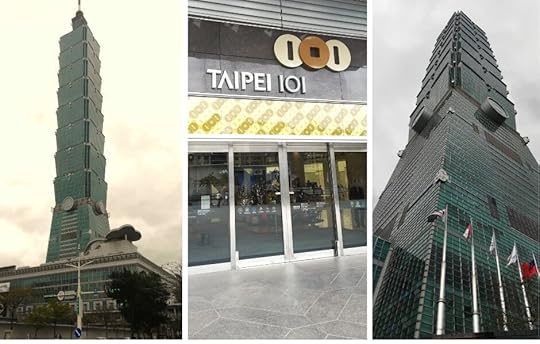
I recommend you buy your e-tickets for the Taipei 101 Tower in advance and online.
Taipei 101 has two observation decks, offering visitors breath-taking panoramic views of the city and to the mountains beyond.
Standard ticket price includes access to the observatory deck on the 89th Floor.
If you want to go higher than the main deck to the Top Deck 101 Floor (VIP Tour) there is a higher ticket price.
Top deck visitor numbers are restricted and booked by available time slots.
I booked a time slot and bought tickets for the Taipei 101 Tower from (affiliate link) Klook.
Klook.com (function (d, sc, u) { var s = d.createElement(sc), p = d.getElementsByTagName(sc)[0]; s.type = "text/javascript"; s.async = true; s.src = u; p.parentNode.insertBefore(s, p); })( document, "script", "https://affiliate.klook.com/widget/fe..." );I thought it worth the extra cost to go to the top deck as you get a drink and access to the World’s Tallest Shangri-La Gardens and to the outside deck area too that’s on the 91st Floor.
Even better are the views of the City of Taipei and the surrounding mountains.

Interestingly for 12 years, the 101 Tower’s elevators were the world’s fasted at 61 kilometres per hour (38 mph).
They still rank amongst the world’s fasted but I can perhaps assure you that the ride is so smooth you’re thankfully unaware of that scary fact while in transit!
 101 Tower’s elevators rank with the world’s fasted!
101 Tower’s elevators rank with the world’s fasted!The 101 Tower website explains the interior design on the 101st Floor:
The 360-degree mirrored wall design on the 101st Floor reflects the sky, clouds and sunlight inside. It is like being in a cloud garden, and with a corner of the observation platform, overlooking the mountains and Taipei city landscape, it is definitely a must-see attraction for your itinerary.
I would agree it’s a dreamy experience.
And, it’s a little quirky, to see animated fluffy pink artificial flower heads moving around and so many cutesy staged sets for photo opportunities.
But, for me, nothing could detract from the amazing views out of the windows.

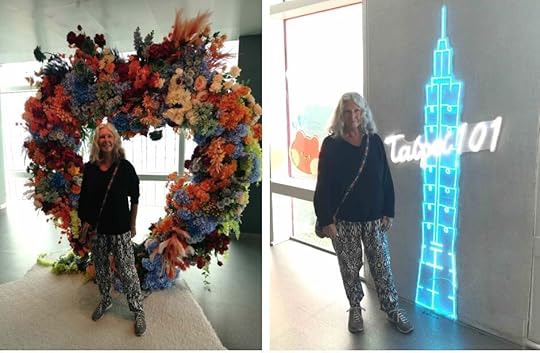 101 – it’s dreamy and a little quirkyEARTHQUAKE PROOF DESIGN
101 – it’s dreamy and a little quirkyEARTHQUAKE PROOF DESIGNFor the backpacking husband, as much as he appreciates a nice view, I know he was looking forward to viewing the science and engineering attributes of the Taipei 101 Tower.
Namely, the giant 660 metric tonne gold-coloured pendulum ‘Taipei 101 ball’ suspended between the 87th and 92nd floor of the inside of the tower that provides high-tech stability during high winds and earthquake tremors.
And, although this anti-sway technique is used in many other tall buildings around the world, the 101 Tower in Taipei is actually unique in that it’s the only place where you can see it openly displayed to visitors.
 The giant gold-coloured pendulum ‘Taipei 101 ball’
The giant gold-coloured pendulum ‘Taipei 101 ball’This example of innovative earthquake-proof mass-damper engineering, is exactly what we’d seen developed at the Earthquake Museum Engineering Building in the Taiwanese City of Taichung, where a devastating earthquake had struck in 1999.
Taipei 101 Tower is still the tallest building built in an earthquake zone.
It’s just 200 meters (660 feet) away from a major fault line.
The structure of the tower was designed to resist an earthquake of nine on the Richter scale.
The viewing area for this giant pendulum is on the 88th Floor.
Do read my full post on The Taiwan Earthquake Museum.
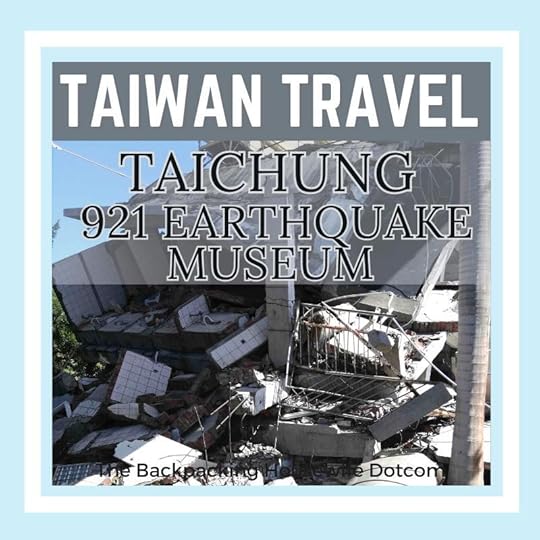 Click to see my post on 912 Earthquake Museum TaichungTAIPEI 101 TOWER FACTS
Click to see my post on 912 Earthquake Museum TaichungTAIPEI 101 TOWER FACTS View of Taipei from the top floor of the 101 Tower
View of Taipei from the top floor of the 101 TowerTaipei 101 – with 101 floors – is an iconic skyscraper in Taipei, Taiwan.
At 508 meters (1,667 feet) high it was the first building in the whole world to surpass the half-kilometre high mark.
For six years, Taipei 101 Tower – when it opened in December 2004 – replaced the Petronas Towers in Kuala Lumpur as the tallest building in the world. Until the Burj Khalifa in Dubai surpassed it in 2009.
The beautiful design of the tower is inspired by traditional Chinese pagodas and bamboo. Elements that symbolize strength and flexibility.
 View of Taipei from the 89th floor of the 101 Tower
View of Taipei from the 89th floor of the 101 TowerThe design of Taipei 101 Tower is influenced by Chinese culture and the lucky number eight which is said to represent prosperity and good fortune. The tower is composed of eight tiers flaring out outward in pagoda style. Each tier has eight floors.
Taipei 101 is equipped with a tuned mass damper, a massive ball-like pendulum suspended from the 92nd to the 88th floor. This damper helps to counteract swaying caused by high winds or seismic activity.
The tower incorporates numerous environmentally friendly features, such as double-pane windows to reduce heat and ultraviolet rays, as well as a rainwater recycling system.
TAIPEI 101 FIREWORKS
Taipei 101 is famous for its spectacular New Year’s Eve fireworks display. It attracts visitors from around the world.
The show is a major event and the fireworks are launched from various levels of the tower.
The tower also has an impressive LED lighting system that allows it to showcase various colourful light displays during special occasions or celebrations.
I was looking forward to seeing this impressive light show in action during the Taiwan Lantern Festival taking place on the First Lunar New Year and while we were in Taipei.
Taipei 101 was constructed using 36,000 pieces of Damper Steel – a type of corrosion-resistant steel.
It took 101 hours to pour the foundation concrete.
Taipei 101 was awarded LEED Platinum certification in 2011, making it one of the world’s greenest skyscrapers.
It has implemented energy-saving measures and environmentally conscious design principles.
The tower has some of the world’s fastest elevators, reaching speeds of 60.6 km/h (37.7 mph).
These elevators take visitors to the observation decks on the 89th and 91st floors in just 37 seconds.
Taipei 101 is home to the original Din Tai Fung restaurant, famous for its dumplings.
The restaurant is located on the ground floor of the tower and attracts food enthusiasts from all over.
See my Travel Guide to Taiwan and the highlights of our fabulous entire 12 Night Taiwan Itinerary.
 Click to see my full 12 Day Taiwan Itinerary
Click to see my full 12 Day Taiwan ItineraryAre you planning a trip to Taiwan?
Are you planning to visit the Taipei 101 Tower?
Let me know in the comments!

The post Taiwan – Taipei 101 Tower appeared first on The Backpacking Housewife.
January 20, 2024
Taiwan – Highlights of Taipei
Our entire and exciting 12 Day Taiwan Travel Itinerary had been meticulously planned around arriving into the Taiwan capital city of Taipei by the 15th Day of the Lunar New Year.
This was to experience the The Taiwan Lantern Festival – an ancient cultural festival – which was being held in Taipei for the very first time in twenty-three years.
This year’s theme was to celebrate the Year of The Rabbit and the festival was completely free to attend.
The backpacking husband and I had arrived in Taiwan a week earlier.
And, from Taipei Main Station, we’d immediately headed south by (THSR) Taiwan High Speed Rail ‘Bullet’ train.
First, to explore the mid-point city of Taichung, staying for three nights.
Then, to continue south to the port city of Kaohsiung.
 Click to see Highlights of Taichung
Click to see Highlights of Taichung
 Click to see highlights of Kaohsiung
Click to see highlights of KaohsiungTable of Contents
HIGHLIGHTS OF TAIPEINORTHBOUND TO TAIPEILIGHT UP THE FUTUREDAY ONE IN TAIPEITAIPEI 101 TOWER: MICHELIN STAR STREET FOOD:DAY TWO IN TAIPEIELEPHANT MOUNTAIN:DAY THREE IN TAIPEITHE LANTERN FESTIVAL NORTHBOUND TO TAIPEI Click to find out about Taiwan High Speed Rail
Click to find out about Taiwan High Speed RailThen, after another three-night stay, we’d returned north along the whole THSR route back to Taipei on the bullet train.
To stay for four nights in the capital city centre.
We stayed at a hotel that we booked using (affiliate link) Booking Dotcom called Inhouse Hotel.
The Inhouse Hotel is in a great central location in the Wanhua District. Just a short walk from Xining MRT Metro station.
Our four nights stay cost USD $378.
After our three nights in each of Taichung City and Kaohsiung City and four nights in Taipei, we spent our very last night in Taiwan at the Air Sky airport hotel at a cost of USD $72 as we had a morning flight from Taipei Taoyuan International Airport.
Over the four nights and five days in Taipei – we explored the city extensively using our easy card on public transport – metro trains and buses – and also by doing lots of walking.
And, of course, we attended The Lantern Festival.
A festival which promised to ‘Light Up The World and Present a Fresh Attitude’.
Our amazing trip to Taiwan would culminate with this extravaganza of lanterns.
How fantastic!
LIGHT UP THE FUTURETaiwan Scene says the theme of the festival is to ‘Light Up The Future‘ and describes the event as “‘Disneyland without roller coasters’ as the festival sites are filled with fun and vibrant installations featuring innovative lighting technology integrated harmoniously with traditional lantern art and culture”.
Travel with me to experience the Highlights of Taiwan’s fabulous Capital City of Taipei!
HIGHLIGHTS OF TAIPEI DAY ONE IN TAIPEI TAIPEI 101 TOWER:I absolutely love a city tower. So visiting the Taipei 101 Tower – which was the world’s tallest building when it first opened in 2004 – was a highlight of Taipei trip.
And, during the Lantern Festival, seeing The Taipei 101 Tower lit up and animated with bouncing pink rabbits in keeping with the theme of The Year of The Rabbit was also a spectacular sight!
Watch my video as we go up the tower for the views of the city below us and to check out the impressive giant gold coloured sphere on display that acts an an earthquake dampener to protect the tower in the event of a tremor!
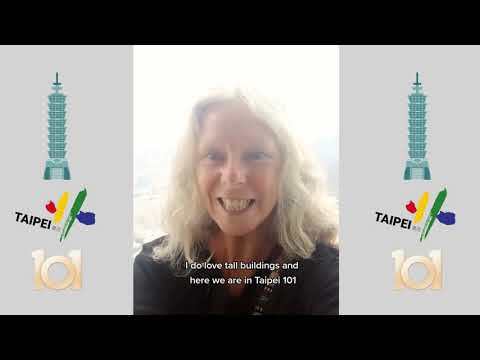
MICHELIN STAR STREET FOOD:
In this post, come with us on a food fest in search of delicious Michelin Star street food at one of the most famous street food markets in Taiwan – The Ningxia Market.
This market is home to no less than FIVE Michelin starred Bib Gourmand street food stalls selling amazing food for just a few $NTD!

DAY TWO IN TAIPEI ELEPHANT MOUNTAIN:
Otherwise known as Xiangshan, this mountain is one of Taipei’s most popular hiking destinations for tourists and locals alike.
It was wonderful to take a leisurely walk out to Elephant Mountain and then a steady climb all 600 steps for a breath taking and panoramic view of Taipei City at the top.
Yes, it was worth it!

DAY THREE IN TAIPEI THE LANTERN FESTIVAL:
The main event was, of course, the Lantern Festival.
The festival is held in the centre of the city in two main areas: The National Dr. Sun Yat-sen Memorial Hall and Taipei City Hall Square.
These feature the Main Lantern – which is of course The Brilliant Light of the Jade Hare – and for the first time the main lantern is using robot technology which is to pay ‘homage to Taiwan’s achievements in the semiconductor industry’.
The Secondary Lantern is The Spiral Dragon which brings prosperity and blessings and is inspired by Chinese folk tales.
The lantern is ‘animated vividly every 30 minutes.’
The star of the Third Lantern is a family of giant Taiwanese blue magpies perched on a colourful tree.
This heart-warming display is also animated with light and sound every 30 minutes.
There are also Six Themed Zones.
The International Friendship Lantern Area invites you to travel around the world with captivating lanterns from Japan and other countries.
Lights of the Future represents beacons of light and a futuristic spirit, vibrant culture and future technologies, including ‘projection mapping’ which will produce cute colourful animated rabbits jumping and running up and down the Taipei 101 Tower. I could hardly wait!

I was so excited for this lantern festival in which many of the ‘lanterns’ were actually what I would describe as ‘festival floats’ as they are huge moulded constructions each lit up to represent different aspects of the Lunar Year and Taiwan’s own cultural celebrations.
I was particularly looking forward to watching the animated displays and light projections.
So don’t miss this special post from Taipei’s Lantern Festival in which we perused the event park in the daytime and then went back after dark to experience the full light show extravaganza!
See my Travel Guide to Taiwan and the highlights of our fabulous entire 12 Night Taiwan Itinerary.
 Click to see my Taiwan Travel 12 Day Itinerary
Click to see my Taiwan Travel 12 Day ItineraryAre you planning a trip to Taiwan?
Will you be travelling to Taichung?
Were my highlights of Taichung helpful to you?
Let me know – I’d love to hear from you!

THE BACKPACKING HOUSEWIFE RECCOMENDS TRAVEL INSURANCE – GET A NO OBLIGATION QUOTE
The post Taiwan – Highlights of Taipei appeared first on The Backpacking Housewife.
January 18, 2024
Taiwan – Liuhe Night Market Kaohsiung
A highlight of Kaohsiung City and a greatly anticipated experience for us was a visit to the traditional Liuhe Night Market (also spelled Liouhe Night Market) in the Xinxing (also spelled Sinsing) District.
Liuhe Night Market is a smaller night market than we’d experienced in Taichung’s Feng Chia Night Market.
But it’s just as well known throughout Taiwan and has an interesting history as the oldest night market in Kaohsiung.
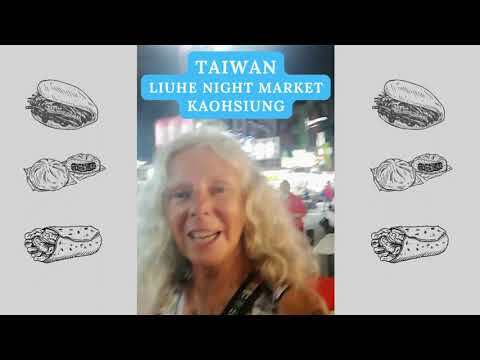
Watch my video of our Liuhe Night Market experience!
Table Of Contents
LIUHE NIGHT MARKET KAOHSIUNG CITYLIUHE NIGHT MARKET STREET FOODPOPULAR STREET FOOD AT LIUHE NIGHT MARKETWHICH AREA TO STAY IN KAOHSIUNGNEXT – NORTHBOUND TO TAIPEIIn the 1940’s the market was known as ‘Dagangpu Night Market’ but as it grew and grew it became known as Liuhe Night Market. It’s also known locally as Liuhe Tourist Night Market.
The market is in the heart of Kaohsiung and flanks both sides of Zhongshan Road.
It is pedestrian friendly and has around two hundred stalls selling street food.
And, with Kaohsiung being a port city, we were looking forward to eating fresh and tasty seafood.

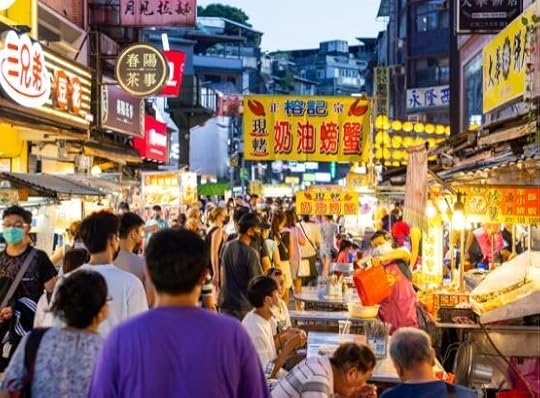 LIUHE NIGHT MARKET STREET FOOD
LIUHE NIGHT MARKET STREET FOODThe Liuhe Night Market is famous for oyster pancakes, fish balls, squid, fresh crab, shrimp, and even lobsters.
It’s also renowned for its Papaya Milk drink and Tiger Milk Tea.
I was particularly looking forward to trying the Bird Egg Shrimp balls (quail egg with a whole shrimp in each) and an oyster omelette!
Plus lots more tasty morsels of authentic typically Taiwanese street food featuring barbeque sausages, soy braised duck, and dumplings straight from the grill or the wok or the steamer!
Street food is an integral part of Taiwanese culinary culture, and the vibrant night markets scattered throughout the island are renowned for their diverse and delicious offerings.
Taiwanese street food is known for its unique flavours, bold combinations, and affordability.
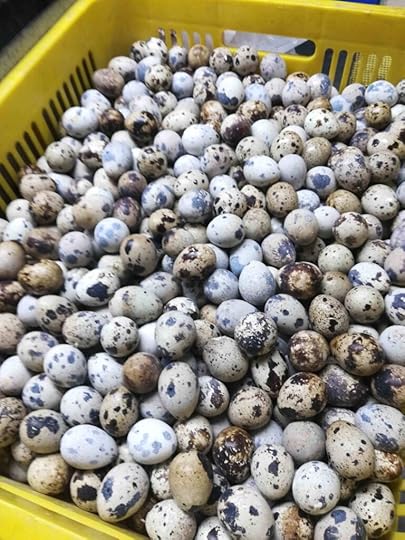
 POPULAR STREET FOOD AT LIUHE NIGHT MARKET
POPULAR STREET FOOD AT LIUHE NIGHT MARKETOyster Omelette (蚵仔煎 – Ò ài jiān): My favourite! This popular street food item features a crispy omelette with fresh oysters, vegetables, and a savoury sauce.
Braised Pork Rice (滷肉飯 – Lǔròu fàn): A simple yet satisfying dish, braised pork rice consists of flavourful minced pork served over a bowl of steamed rice. It’s often garnished with pickled mustard greens and sometimes a boiled egg.
Gua Bao (割包): The backpacking husband’s favourite! Also known as “Taiwanese hamburger.” Gua bao consists of a steamed bun filled with braised pork belly, crushed peanuts, cilantro, and pickled vegetables.
Stinky Tofu (臭豆腐 – Chòu dòufu): I’m not a fan but despite its strong odour, stinky tofu is a beloved Taiwanese snack. It is deep-fried fermented tofu and is often served with pickled cabbage and a spicy sauce.
Grilled Squid (烤魷魚 – Kǎo yóuyú): Fresh squid is marinated, skewered, and grilled to perfection, often brushed with a savoury soy-based sauce. It’s a popular and tasty seafood option.
Scallion Pancake (蔥油餅 – Cōng yóu bǐng): A second runner to the oyster omelette! A savoury and flaky flatbread, scallion pancakes are made by folding layers of dough with chopped scallions and pan-frying until crispy.
Taiwanese Sausages (香腸 – Xiāngcháng): These sweet and savoury sausages are often grilled and served on a stick. The flavours can range from garlic to Chinese five-spice. Delicious!
Taiwanese Fried Chicken (鹽酥雞 – Yán sū jī): Deep-fried chicken chunks, seasoned with a flavourful mixture of spices, are a popular street food choice. They are often served with fried basil leaves.
Dan Bing (蛋餅): Dan bing is a thin, savoury pancake rolled with a variety of fillings such as eggs, cheese, ham, and sometimes crispy crullers (you tiao).
Bubble Tea (珍珠奶茶 – Zhēnzhū nǎichá): See my post on our visit to The Original Bubble Tea Shop in Kaohsiung because bubble tea originated in Taiwan and has become a global phenomenon. It consists of sweet milk tea with chewy tapioca pearls. Variations may include fruit flavours, different types of milk, or even blended ice.
When visiting Taiwan, exploring the bustling night markets and trying these amazingly diverse street foods is a must for any foodie.
Each Taiwanese region and each market will have its own specialties so be sure to sample the local delights wherever you go.

 WHICH AREA TO STAY IN KAOHSIUNG
WHICH AREA TO STAY IN KAOHSIUNG
 Click the image to see my Highlights of Kaohsiung City
Click the image to see my Highlights of Kaohsiung CityWe’d actually chose our hotel in the central Xinxing District of Kaohsiung city because of its location in the very next street to the Liuhe Night Market!
We stayed for three nights at (affiliated link) The Cloud Hotel (we paid $41 USD per night).
We booked this hotel near Liuhe Night Market with (affiliated link) Booking Dotcom.
The Cloud Hotel was very nice and a perfect location not only for the Liuhe Night Market but it’s only a short walk from Formosa Boulevard MRT Station.
The Formosa Boulevard MRT station where you can see The Dome of Light – the world’s largest glass artwork!
From there, walk towards to Zhongshan 1st Road to Liuhe Night Market.
We found it really easy to get around Kaohsiung and to travel extensively around the city and to all the popular tourist sites using public transport and using The Easy Card. See my post on Should I Buy An Easy Card for travel in Taiwan,
NEXT – NORTHBOUND TO TAIPEINext on our 12 Day Taiwan Itinerary is Taipei – the capital of Taiwan – and we had big adventurous plans!
After our fabulous few days exploring Kaohsiung we were taking the northbound Taiwan Bullet Train (THSR) all the way back up to Taipei.
Over the next six days and five nights we intended to fully explore this so far unknown to us city.
From the top of the 101 Taipei Tower to the length of the most famous of Taiwan’s street markets – the Ningxia Market – with its coveted Michelin Star Street Food!
THEN on the 15th day of the first lunar month – to mark the grand finale of the Chinese New Year celebrations – the Taiwan Lantern Festival will be taking place in Taipei for the first time in twenty-three years!
Join me on my travels through Taiwan culminating with the Lantern Festival!
 Click to see my 12 Day Itinerary for exploring Taiwan
Click to see my 12 Day Itinerary for exploring TaiwanAre you planning to visit Taiwan?
Will you go south to Kaohsiung?
Let me know in the comments!

The post Taiwan – Liuhe Night Market Kaohsiung appeared first on The Backpacking Housewife.
January 15, 2024
Taiwan – Cijin Island From Kaohsiung
Cijin Island – also often spelled Qijin and Chijin – is a wonderful day trip with seaside vibes that’s easily reached from Kaohsiung City.
It’s just a short and enjoyable ten-minute ferry ride from Gushan Pier over to Cijin Island and the island is so small that it’s easily explored in a day.
Cijin Island offers both tourists and city slickers a breath of fresh air and a chance to stretch your legs in Cijin seaside park.
 Gushan Pier Kaohsiung ferry over to Cijin Island
Gushan Pier Kaohsiung ferry over to Cijin IslandBut if walking is not your thing – no problem.
You can easily hire a rickshaw, an electric golf cart, a scooter, or an electric or manual bicycle to get around at your own pace.
Foodies might consider the fresh food scene on Cijin to be the main attraction.
There are certainly lots of street food venues and seafood restaurants on Cijin’s ‘Old Street’ that is also locally known as ‘Seafood Street.’
Those of you whom appreciate culture will want to explore Cijin’s ancient temple to the Sea Goddess and Fishermen and The Sea.
If you love art, then the quirky modern art installations along the beachfront will delight you, and then you might also explore Cijin Shell Museum.
The Cijin Shell Museum apparently displays 3000 seashells.
I love a beach – and Cijin Beach is a rare spectacle with its black sand!
If I stayed in Taiwan, I would choose to live in Kaohsiung for the city life while knowing I could easily take a ten-minute ferry ride for my weekend island beach fix!
Table of Contents
THINGS TO DO ON CIJIN ISLANDEAT AND DRINKTAKE PHOTOSENJOY THE BEACHHIRE A BICYCLECIJIN ART INSTALLATIONSSEA PEARL LISTENING POINTSECRET VOICES FROM THE OCEANTIANHOU TEMPLEGO PADDLEBOARDING AND EXPLORE THE SEA CAVEBEST TIME TO VISIT CIJIN ISLANDHOW TO GET TO CIJIN ISLAND FROM KAOHSIUNGTHINGS TO DO ON CIJIN ISLAND EAT AND DRINK Pretty streets on Cijin Island
Pretty streets on Cijin IslandOnce off the ferry, you’ll find lots of shops and a 7-11 and assorted places to eat and drink all the way along to the beachside promenade.
Cijin is famous for its seafood.
Throughout the summer the beach bar is open and provides a perfect spot to sit and relax and with a cocktail and enjoy harbour and beach views.
In July/August you can enjoy the beer festival held every Saturday.
Or enjoy Taiwan’s famous Bubble Tea or shaved ice and delicious ice cream.
TAKE PHOTOS The Backpacking Housewife at The Cijin Sign
The Backpacking Housewife at The Cijin SignCijin is so photogenic – from the colourful giant Cijin Sign at the start of the beach to all the art installations along the promenade.
Although, you might have to wait in line to get your perfect shot during the summer, when the island is especially popular with both locals and tourists.
When we were there, it was early springtime, and we mostly had the place to ourselves. The downside was that there weren’t so many places open yet.
Indeed, when we were on the island, the seashell museum was closed.
ENJOY THE BEACH Cijin Beach is a rare spectacle with its black sand!
Cijin Beach is a rare spectacle with its black sand!Also in July/August, on the beach, the Annual Black Sand Castle Festival takes place and you’ll be able to see impressive sand sculptures on the beach.
Cijin’s beach is approximately 1.5 km long and is lined with palm trees.
But it’s not a beach you can swim from easily from because of strong currents.
It is however a popular beach at certain times of the year with wave surfers and wind surfers.
HIRE A BICYCLE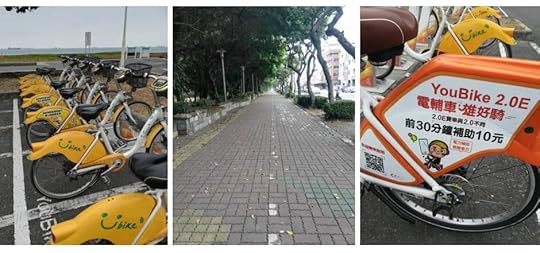 You can easily hire a bike or scooter on Cijin Island
You can easily hire a bike or scooter on Cijin IslandYou can easily rent a scooter or a bicycle on Cijin.
There is a You Bike Station adjacent to the beach where you can rent a bicycle using your Easy Card to get a discounted rate.
But – be warned – you’ll first need to register online using the YOU BIKE APP.
A cycle path/pedestrian paved path runs the whole way alongside the beach.
The path leads to some interesting stops along the route to the northern part of the island.
Here you’ll find Cijin’s iconic 19th Century lighthouse, a modern fort with Qing Dynasty foundations, and a grassy park area that’s perfect for a picnic.
 Cijin’s Iconic Lighthouse
CIJIN ART INSTALLATIONS
Cijin’s Iconic Lighthouse
CIJIN ART INSTALLATIONS
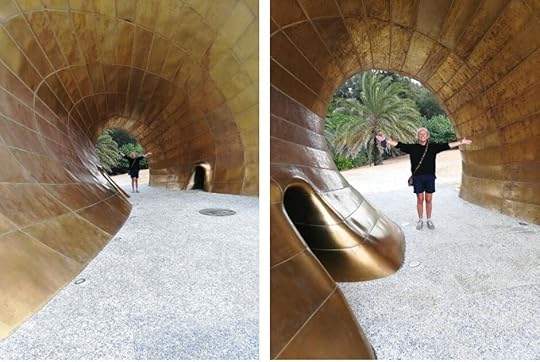 Inside the giant Sea Pearl Shell
Inside the giant Sea Pearl ShellI had my photo taken at the giant (10 metre tall) Cijin Sea Pearl Shell.
I also enjoyed seeing the fishermen sculpture representing the traditional industry here. And the colourful (so called) Rainbow Church which is a modern art installation of colourful frames set in a reflection pool.
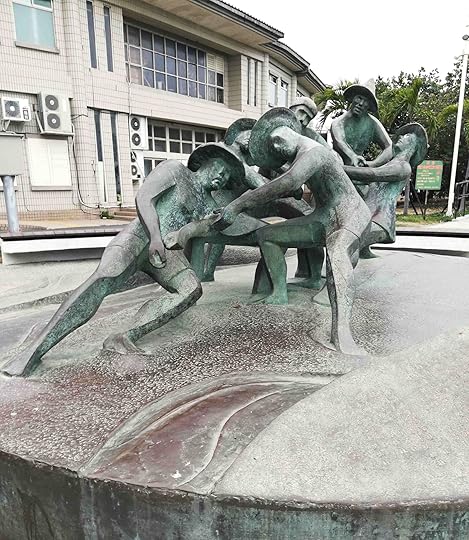
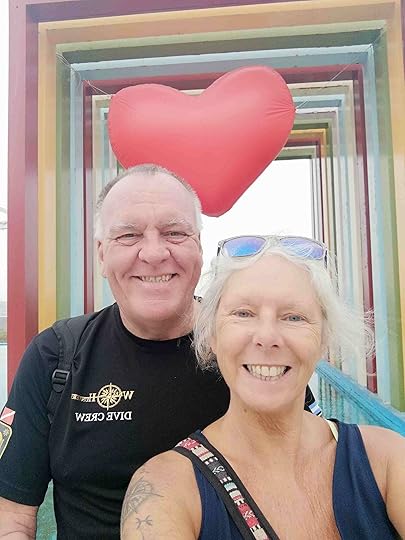 SEA PEARL LISTENING POINT
SEA PEARL LISTENING POINT
 Sea Pearl Listening Point
Sea Pearl Listening PointThe interactive Sea Pearl Listening Point in the shape of ‘trumpet shells’ or ‘double snail shells’ is an interesting art installation and a feature claiming ‘Secret Voices From The Ocean’ on the promenade outside the seashell museum.
I absolutely loved the idea behind this and it is possible to stand between the shells and hear the amplified echo of waves from the sea!
There is a plaque on the floor that explains the function and the significance of this art in relation to the ocean and to the Harbour City of Kaohsiung.
I’ve quoted it below for you as I found it quite beautiful!
Secret Voices From The OceanDesign Artist: Lin Shuen-Long. Sound Collaboration: Atelier Hui-Kan. Year: 2014
TIANHOU TEMPLELiving in the ocean clams grow into beautiful forms through continual accumulation. Sometimes a clam may heal a wound or coexist with a foreign object by coating it in order to form dazzlingly beautiful pearls within its body.
This is similar to how Kaohsiung has integrated an array of residential cultures through the passage of time as well as urban appearances which historical rulers have planned and accumulated over time. Nowadays it exhibits the spirit of a unique harbour city: a combination of ruggedness, quality, vitality, and gentleness.
Sea Pearls neighbours the Shell Museum in Cijin, Kaohsiung, and faces the ocean.
It’s steady, elegant form and exquisite artisanship and materials echo this harbour city’s traits. In addition to highlighting industrial characteristics, emphasis is also placed on cultural sights and ecological concern.
Standing under the golden embrace of Sea Pearls, basking in the sea breeze and warm rays of the sun, one is surrounded by all the intricate noises of the sea in the vivid ocean space within.
People on either side of this space can also converse with each other through the sound tube, inadvertently breaking the confines of space so that one’s senses and imagination can observe even the most meticulous details and soar towards a deeper understanding of the living need to coexist with nature.
As you explore Secret Voices From The Ocean: Sea Pearls Listening Point please take the time and listen carefully to these messages from nature at the Listening Point.
Curation: DADA Idea Co. Ltd.
 Tianhou Temple honours Matsu – the Goddess of Fishermen and the Sea.
Tianhou Temple honours Matsu – the Goddess of Fishermen and the Sea.The most important temple of Cijin is the beautiful Tianhou Temple which honours Matsu – the Goddess of Fishermen and the Sea.
Its origins go back to the 12th year of Emperor Kangxi of the Qing Dynasty (1673).
Legend tells of a fisherman founding the temple here in gratitude after being washed him up on the island and saved from drowning during a typhoon.
GO PADDLEBOARDING AND EXPLORE THE SEA CAVE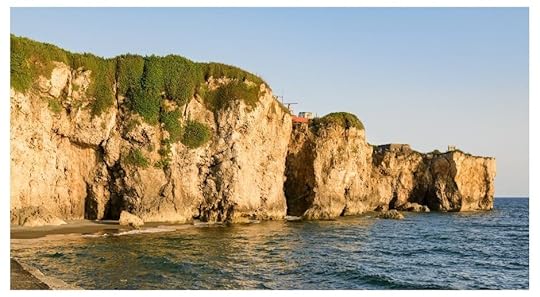 Cijin Island Sea Caves
Cijin Island Sea CavesIn the summer months when the weather is hot and humid and the sea is calm then getting out on the sea on a paddleboard is a fun and cool thing to do.
It’s interesting to see the Cijin Sea Caves but I would recommend a tour under the supervision of a knowledgeable guide.
Click my Klook banner below to find out more.
Note: Some of my links are affiliates links and if you purchase through my link I will receive a small commission that helps support the cost of running this website. Thank you very much for your support.
Klook.com (function (d, sc, u) { var s = d.createElement(sc), p = d.getElementsByTagName(sc)[0]; s.type = "text/javascript"; s.async = true; s.src = u; p.parentNode.insertBefore(s, p); })( document, "script", "https://affiliate.klook.com/widget/fe..." ); BEST TIME TO VISIT CIJIN ISLANDCijin Island, located off the coast of Kaohsiung, Taiwan, shares a climate similar to the mainland. The best time to visit Cijin Island aligns with the generally favourable weather conditions in the region. Consider visiting during:
Autumn (October to December): This is a fantastic time to explore Cijin Island. The weather is comfortable, with cooler temperatures and lower humidity. It’s an ideal time for outdoor activities, and you can enjoy the beautiful scenery without the discomfort of summer heat.
Spring (March to May): Spring is another excellent time to visit Cijin Island. The temperatures are mild, and the island may be adorned with blooming flowers. This season offers pleasant weather for walking, biking, or simply enjoying the coastal atmosphere.
Early Summer (May to June): If you prefer warmer temperatures but want to avoid the peak of summer heat and humidity, early summer can be a good compromise. However, be aware that the weather may be more unpredictable, and occasional rain showers are possible.
Summer (June to September): This is the hottest and most humid time of the year. Daytime temperatures can exceed 30°C (86°F), and the humidity levels can be uncomfortable. Additionally, typhoon season in Taiwan typically occurs from June to October, which can bring heavy rainfall and strong winds.
If you plan to visit during June to October do keep an eye on the weather forecast and be prepared for potential changes in weather conditions.
Ultimately, the best time to visit Cijin Island depends on your personal preferences for weather and the activities you’ll plan while on the island.
HOW TO GET TO CIJIN ISLAND FROM KAOHSIUNGFrom Kaohsiung City to get to Gushan Pier you can use your Easy Card on public transport and get a discounted rate.
From Sizihwan Station (orange line) or Hamasan Station (green line).
Or take the #50 bus from Koahsiung Central Park
Ferries depart from Gushan Pier to Cijin Island every ten minutes.
Cijin Island was a real highlight of our few days in Kaohsiung!
 Click to read my post Highlights of Kaohsiung City
Click to read my post Highlights of Kaohsiung CityWATCH MY SHORT VIDEO FILMED ON CIJIN ISLAND!
It is a perfect day trip and I’d highly recommend Cijin Island as part of your Taiwan Itinerary

Highlights of our day trip to Cijin Island from Kaohsiung
Have you ever been to Cijin Island?
Have you ever been to Kaohsiung?
Is Taiwan on your travel wish list?
Let me know in the comments!
 Click to see my 12 Day Taiwan Itinerary!
Click to see my 12 Day Taiwan Itinerary!The post Taiwan – Cijin Island From Kaohsiung appeared first on The Backpacking Housewife.
January 14, 2024
Taiwan – Highlights of Kaohsiung City
The historic port city of Kaohsiung is the third largest city in Taiwan after Taipei and Taichung and is the largest city in the south of Taiwan.
Kaohsiung has an international airport but we’d arrived in Kaohsiung by ‘Bullet Train’ on Taiwan High Speed Rail (THSR) travelling from the north after spending four days and three nights in the Mid-Taiwanese City of Taichung.
Our next exciting point of call in our fabulous 12 Day Taiwan Itinerary was to be Kaohsiung.
It is, of course, impossible to see and experience all that this vast city has to offer the visitor in just a few days – but we kept to a full itinerary – and I want to share with you our Highlights of Kaohsiung City!
Table of Contents
HIGHLIGHTS OF KAOHSIUNG CITYKAOHSIUNG PORTWHAT TO DO IN KAOHSIUNG CITYTHE LOVE RIVERTHE DOME OF LIGHTCIJIN ISLANDCIJIN BEACH ART INSTALLATIONSLIUHE NIGHT MARKETWHERE TO STAY IN KAOHSIUNGNORTHBOUND TO TAIPEI KAOHSIUNG PORT Kaohsiung Port City
Kaohsiung Port CityKaohsiung Port was first established in the 1680s from a natural lagoon. Since then it has gone from being a military port to be developed into Taiwan’s largest commercial harbour.
WHAT TO DO IN KAOHSIUNG CITY THE LOVE RIVER 石萬里 Public domain via Wikimedia Commons: Long ago on Love River – Kaohsiung.
石萬里 Public domain via Wikimedia Commons: Long ago on Love River – Kaohsiung.The Love River: From the port estuary a river flows for twelve kilometres through Kaohsiung City.
Just as London has The Thames and Paris has the Seine, Kaohsiung has Love River.
A riverside park offers locals and tourists a place to relax, to walk, to eat, and to admire street art.
And, on the river itself, you can take a romantic cruise.
Interestingly, it was from a romantic river cruise that The Love River got its name.
Originally it was just called ‘Kaohsiung River’. Until a sign advertising a ‘Love River Cruise’ was damaged in a typhoon and the ‘Cruise’ part of the sign disappeared to leave ‘Love River’ and that is the name that stuck!
THE DOME OF LIGHT
The Dome of Light: In central Kaohsiung, at Formosa Boulevard MRT Station, is the world’s largest glass artwork with 400 multicoloured glass panels set over a 30 meter diameter area.
It is literally a dome of light and is stunningly beautiful and so unexpected.
What a surprise to see such an amazing art installation on the ceiling of a busy metro station!
The design is the vision of an Italian-born artist from Mexico called Narcissus Quagliata.
It took Quagliata four years to complete the Dome of Light, which tells the story of human life on its four-colour coordinated main panels.
The emphasis on blue represents water and the Womb of Life through green growth and orange creation and finally fiery red and yellow ochre for death and rebirth.
A must-see while in Kaohsiung City!
CIJIN ISLAND
Cijin Island: Another must-do experience from Kaohsiung is to take the short ten-minute ferry ride from Gushan Pier over to Cijin Island.
It’s a perfect day trip and a top thing to do in Kaohsiung.
Use your Easy Card to Gushan Pier from Sizihwan Station (orange line) or Hamasan Station (green line).
Or take the #50 bus from Kaohsiung Central Park
Ferries depart from Gushan Pier every ten minutes.
Once on Cijin Island you’ll find lots of shops and a 7-11 and places to eat and drink along ‘Cijin Old Street’.
The Old Street leads to the Cijin Sign (perfect for a photo) and the black sand beach.
All along the length of the beach is a paved promenade and cycle path.
CIJIN BEACH ART INSTALLATIONS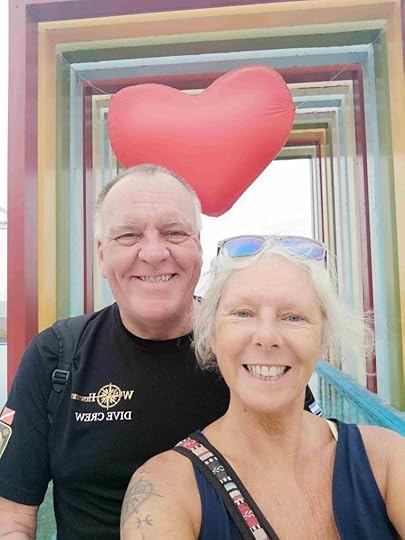 At The Rainbow Church art installation Cijin Beach
At The Rainbow Church art installation Cijin BeachCijin Island Art and Culture: We enjoyed a walk along the beachside path, stopping to sit and admire the view from bench and to take photos at stop offs like The Rainbow Church which is an art installation of colourful frames in a reflection pool.
I also enjoyed the interactive seashell art installations. It is possible to hear the echo of waves from the sea!
There are also several beautiful and ancient temples on Cijin Island that honour the Goddess of Fishermen and the Sea.
Cijin Island felt like a breath of fresh air and was a real highlight of our time in Kaohsiung!
LIUHE NIGHT MARKET
Another highlight and greatly anticipated – experience for us was a visit to the traditional Liuhe Night Market in the Xinxing District of Kaohsiung.
This is a smaller night market than the one we’d experienced in Taichung but it is just as well known throughout Taiwan and it is famously the oldest night market in Kaohsiung.
We’d actually chosen our hotel because it’s located in the very next street to the Liuhe Night Market.
As Kaohsiung is a port city we were especially looking forward to eating fresh and tasty seafood.
We were also looking forward to trying more authentic typically Taiwanese street food straight from the grill or the wok or the steamer!
 Click on the image to see my full Taiwan 12 Day Itinerary
WHERE TO STAY IN KAOHSIUNG
Click on the image to see my full Taiwan 12 Day Itinerary
WHERE TO STAY IN KAOHSIUNG
We stayed for three nights in the central Xinxing District of Kaohsiung city at The Cloud Hotel (we paid $41 USD per night).
We booked this hotel in with (affiliated link) Booking Dotcom.
We thought The Cloud Hotel was very nice and a perfect location not only for the Liuhe Night Market but it’s only a short walk from Formosa Boulevard MRT Station – where you can admire the aforementioned Dome of Light – the world’s largest glass artwork!
It’s really easy to get around Kaohsiung on foot and using public transport with the Easy Card.
After our fabulous few days exploring Kaohsiung, we were taking the northbound Bullet Train (THSR) all the way back up to Taipei.
In Taipei – the capital of Taiwan – we had big adventurous plans!
NORTHBOUND TO TAIPEI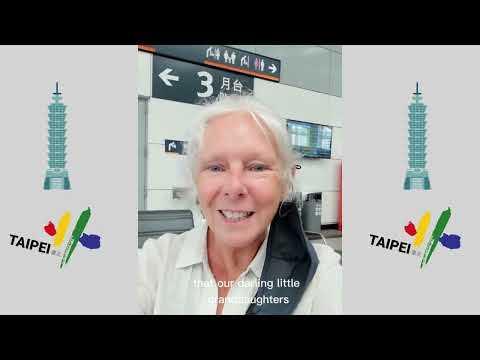
Northbound to Taipei! Over the next six days and five nights we intended to fully explore this so far unknown to us Capital City of Taiwan.
For the views from Elephant Mountain to the top of The 101 Taipei Tower to the length of one of the most famous of Taiwan’s street markets – the Ningxia Market – with its coveted Michelin Star Street Food!
THEN on the 15th day of the first lunar month – to mark the grand finale of the Chinese New Year celebrations – the Taiwan Lantern Festival will be taking place in Taipei for the first time in twenty-three years!
Join me on all my fabulous travels through Taiwan culminating in Taipei with The Lantern Festival!
Are you planning to visit Taiwan?
Will you go south to Kaohsiung?
Let me know in the comments!
 Klook.com (function (d, sc, u) { var s = d.createElement(sc), p = d.getElementsByTagName(sc)[0]; s.type = "text/javascript"; s.async = true; s.src = u; p.parentNode.insertBefore(s, p); })( document, "script", "https://affiliate.klook.com/widget/fe..." );
Klook.com (function (d, sc, u) { var s = d.createElement(sc), p = d.getElementsByTagName(sc)[0]; s.type = "text/javascript"; s.async = true; s.src = u; p.parentNode.insertBefore(s, p); })( document, "script", "https://affiliate.klook.com/widget/fe..." );The post Taiwan – Highlights of Kaohsiung City appeared first on The Backpacking Housewife.












